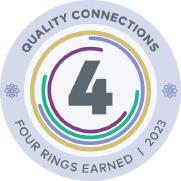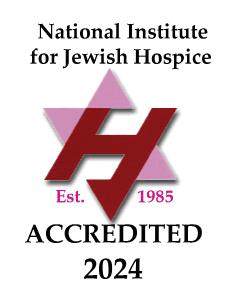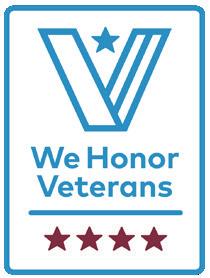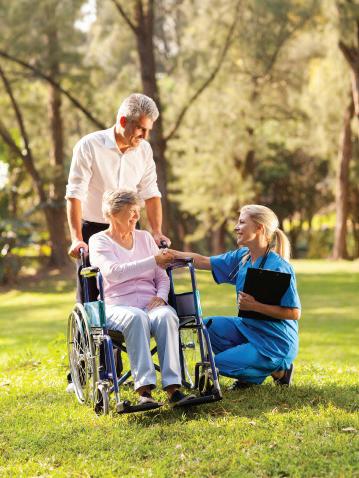

Patient & Family Hospice Care Training Guide
“Song”
If space and time, as sages say, Are things which cannot be, The fly that lives a single day Has lived as long as we. But let us live while yet we may, While love and life are free, For time is time, and runs away, Though sages disagree. The flowers I sent thee when the dew Was trembling on the vine, Were withered ere the wild bee flew To suck the eglantine. But let us haste to pluck anew Nor mourn to see them pine, And though the flowers of love be few Yet let them be divine.








—T.
S. Eliot, 1888–1965














Your Life. Our Passion. My Promise.
A Letter from Tony Maxwell, President
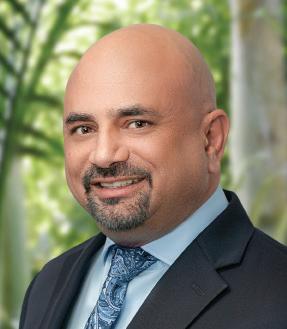
I know that this is a difficult time for you and your family. A life-limiting illness shakes the very foundation we come to rely on throughout our lives, knocking us off center into unknown territory. But be assured that if you or someone you love has entered hospice care, you can now rely on the experienced, compassionate professionals at Trustbridge to support you. We are here for you. You are not alone.
You may not know how to negotiate the uncertainties that lie ahead, and your emotions may be running the gamut from shock and disbelief to confusion, anger and despair. It is also likely that you have many questions. All of this is normal and expected. Our staff will answer your questions, provide you with practical and emotional support, help ease pain, and guide you and your loved ones toward clarity, acceptance and peace. Although this is a trying time, the hospice experience can also be a positive experience. Our goal is to help all of you make the most of your time together, so that each day can be lived to its fullest.
Over the past several decades, we have helped 200,000 families in Palm Beach County and Broward County through serious illness. We are honored to include you among the Trustbridge family, and we appreciate your trust in us. You will be meeting many of our staff in the coming days and weeks, and I encourage you to look at them not as strangers but as people who truly care about you and your well-being.
The Trustbridge staff is committed to providing all patients, caregivers, and their families with the very best care. Because your life is our passion, you have my heartfelt promise that we will do our very best to help everyone through this end-of-life transition. My sincere hope is that, during this journey, you will find much love, peace and, yes, even joy in your moments together.



Tony Maxwell
Tony Maxwell, President

About Trustbridge
Since 1978, Hospice of Palm Beach County and Hospice by the Sea have cared for 200,000 families in South Florida. These hospices are now Trustbridge, a community nonprofit that provides unparalleled support for families facing serious illness.
Trustbridge services include hospice care, palliative medicine, caregiver support, and grief support for children and adults.
National Recognition




Trustbridge’s unmatched levels of hospice care have been nationally recognized for excellence, earning the Joint Commission National Quality Seal of Approval for both Palm Beach and Broward counties. We are the only hospice with this distinction in both counties. We are licensed by the Agency for Healthcare Administration for Medicare and Medicaid Benefits for Floridians, and accredited by the Palm Beach County Board of Rabbis. We are members of the National Hospice and Palliative Care Organization, Florida Hospices and Palliative Care, Inc. and the National Association for Home Care.
Your feedback is important...
Trustbridge has contracted with SHP, a third-party vendor approved by the Centers for Medicare and Medicaid Services (CMS) to conduct the mandatory Consumer Assessment of Healthcare Providers and Systems (CAHPS) survey. SHP may contact your caregiver or family member by mail after your loved one is no longer in our care to evaluate the quality of services and care you and your loved ones received from Trustbridge. Your survey will arrive in an envelope similar to the one below.
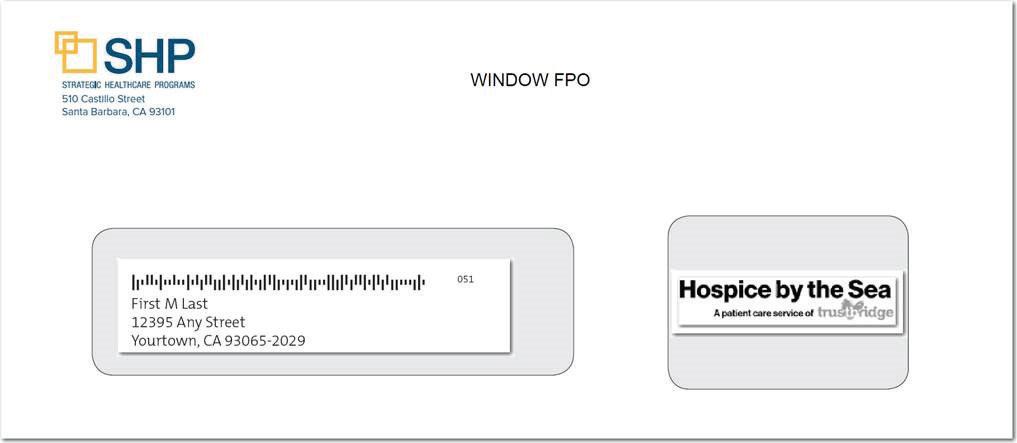
As the primary caregiver, you oversee the care of your loved one and can let us know if we’ve met your needs by completing the survey that is mailed to your home. Trustbridge supports the survey process because it helps us align our care in the way to best serve our patients and families and helps future patients make informed decisions when choosing an end-of-life provider.
Please share your experiences and help others by completing and returning this survey within 30 days of receipt. Thank you for entrusting your care to us and helping us ensure that every patient and family receives the level of care they deserve at the end of life.
Welcome to Trustbridge
When you or your loved one is facing a life-limiting illness, you may feel frightened, alone and uncertain—as if the ground beneath you had suddenly collapsed. Trustbridge is here to bridge the gap between what has been your normal life and the unfamiliar terrain that lies ahead of you. We are trained to provide you with outstanding patient care and to help you and your family find clarity, comfort, and peace. However, our training is secondary to why we are all here in the first place: We’re here because your life truly is our passion. While we know how difficult this experience can be, we want to assure you that hospice can also be a positive experience, offering you an opportunity to make the most of your time together.
In this booklet, we will guide you toward an understanding of what hospice care is, what you might expect in the days and weeks ahead, and how we can support you and your family. We make every effort in this guide to speak to both the patient and the family. Please know that whichever category you fall into or however this guide is worded, the material here can provide you with important information and insight. We suggest that you look through this guide page by page. Please ask us to clarify anything you don’t fully understand or anything you would like to know more about. We’re here for you. Call our 24-hour support line at 888.441.4040 whenever you need to.
At Trustbridge, we are focused on hope— hope for a fulfilling life, even in the face of serious illness.

What You Need to Know
Think of your relationship with Trustbridge as a meaningful partnership. We are here to help you and your loved ones navigate the journey ahead. Some days and nights may be bumpier than others, but there is no need to feel frightened or alone. Whether you are a patient, a caregiver, or a concerned friend or family member, Trustbridge is here to support you. In fact, that’s the purpose of hospice care: to provide the support you and your loved ones need to live your lives to the fullest extent possible. We encourage you not to overlook the life and love that are still remaining. Every moment counts.
What exactly is hospice?
Hospice is a special type of supportive care that is focused on providing comfort—relieving physical, emotional and spiritual suffering. The goal of hospice care is to improve the quality of life through a comprehensive set of services identified and coordinated by an interdisciplinary team, to provide for the patient’s physical, emotional, psychological and spiritual needs.












How can we help?
At Trustbridge, our goal is not life centered on care, but care centered on life. Our mission is to support the wishes of our patients and families like you whenever possible so you can live the way you want and do the things that are important to you. Keeping those goals of care in mind, your Trustbridge team will design a unique plan of care that best suits your needs. The plan of care is fluid, meaning that it will change as circumstances and needs change.
If you or your loved one needs comfort care such as radiation, chemotherapy, intravenous medications or blood transfusions, Trustbridge can provide that care. We are one of only 4 percent of hospice organizations nationwide that can admit patients into hospice care and provide these extraordinary comfort measures.
24/7 Telephone Support | 888.441.4040
A knowledgeable, skilled member of the Trustbridge staff is available by phone every minute of every day. Please call us if you require assistance, have a question, experience a troubling symptom, need caregiver instructions, or just want someone to talk to. We want to help ease your concerns and address your needs. That’s our purpose and passion.
While in hospice, we want you or your loved one to be as comfortable as possible and to be able to spend meaningful time with family and friends. Quality of life is our priority. We want the caregiver to be supported and empowered. Our staff members are not only skilled in pain and symptom management, but they also are prepared to provide training, comfort and support to the entire family as needed.
Depending on the plan of care, the following services are available:

24-hour telephone support
Expert clinical care and symptom management
Medications, equipment and supplies delivered to the patient’s bedside
Caregiver training and support
Emotional and spiritual support
Guidance in making complex care decisions and locating essential community resources
Music therapy to reduce pain, anxiety and other symptoms
Pet therapy to provide comfort and an emotional boost
Support programs for children, teens and adults

Volunteer support to provide additional help for families



The First Week: What to Expect
All new experiences come with a little uncertainty, and entering hospice care is no different. Due to these unique circumstances, however, it is also common to feel some fear and trepidation, and you may even feel a little infringed upon. This first week will likely be the busiest, so try to be patient and know that you will have private time to spend with your family and loved ones when everything is in place. In the meantime, the following is a brief rundown of what generally takes place the first week.
Visits from Hospice Team Members
You can expect visits from several hospice team members during the first week of care. These visits will allow us to assess all of your family’s needs and get your or your loved one’s symptoms stabilized. Together, we will create a plan of care according to the needs, goals and traditions of each patient and family. Further visits from hospice team members will be scheduled according to the plan of care, so you will know whom to expect and when.
The team members who visit will be skilled, compassionate and knowledgeable. They can answer any questions you have or get the answers for you. Do not hesitate to ask whatever is on your mind. (See the description of the hospice team members on page 15 of this booklet.)

Delivery of Medications, Equipment and Supplies
The Medicare hospice benefit provides for the care, treatment and services related to the terminal condition. That includes medication, equipment and supplies needed to care for you or your loved one. The medication, equipment and supplies that the medical team determines to be necessary for the patient’s care will be delivered directly to the bedside. Medication and supplies will be replenished as needed. The purpose and use of these items will be explained as clearly as possible so that they don’t seem so foreign to you. Ask for an explanation of anything you don’t understand.
Caregiver Training and Support
Our staff will train caregivers, with compassion and patience. Training may include such things as pain medication and when to give, side effects of medications, as well as, what to do for shortness of breath and, or anxiety. Our staff will also train caregivers on how to use the equipment and supplies provided by the medical team, as needed. Some of the equipment is designed to take the physical burden off the caregiver. Our staff will also train the caregiver to perform daily tasks and will assist with tasks the caregiver may not be able to perform.
Are You the Caregiver?
No one is truly prepared to care for an ill loved one. Even people who work in the healthcare field find that their professional skills drop away when it comes to caring for a family member. It is entirely normal to feel uncertain and overwhelmed. Please know that we are here for you. Your well-being is as important as the well-being of your loved one.

Please share with us anything that is on your mind concerning your caregiving responsibilities. As your loved one’s needs change, we will educate you so you will understand what is happening and know what to anticipate. If you feel sad, tired or overwhelmed with your caregiving responsibilities, you can count on our staff for counseling, respite support or advice.
Please refer to our booklets, A Caregiving Journey: Caring for Your Loved One and Yourself and A Very Special Journey: Familiarizing Yourself with the End-of-Life Transition. If you don’t have copies of the booklets, please request them.
Call us at 888.441.4040 if you have a caregiving question or need reassurance. Our nurses will answer your questions and send someone to help if necessary.








After the First Week
After the first week, the plan of care may start to feel routine, at least for a while. It will change as your needs or the needs of your loved one change. Since everyone’s journey is unique, none of us can say for certain exactly what’s to come. However, we can say for certain that the moments remaining hold many opportunities to share memories, make amends, deepen relationships, express love and hope, and simply be together. We can also say for certain that Trustbridge will be with you every step of the way, bringing hope for a fulfilling life even as the journey nears completion.
The connection between you and your loved ones, together with our passion to provide comfort and support, is a powerful combination.

“ When hospice came into
our
lives,
we began to breathe again. Before, we had been overwhelmed trying to handle medical, emotional
and
spiritual issues
we weren’t prepared for. They gave us enormous comfort and relief and helped us more than I could ever have imagined. ”
The Levels of Hospice Care
Wherever hospice care is provided, Trustbridge professionals are experienced in alleviating distress, relieving pain and suffering, and helping you and your loved ones discover your inner source of strength, support and hope. Some families come into our care for many months and enjoy the improved quality of life that our services can provide. Others only come to us in their final weeks. Whatever amount of time you spend with us, it is an honor to be of service to you.
With the understanding that this journey presents an ever-changing landscape, the following is a brief description of the different levels of hospice care that may be available based on your individual need:
Routine Home Care
Routine home care is provided in the patient’s home. That home can be a private residence, or in a skilled nursing facility, assisted living facility or group home. The day-to-day hands-on care is provided by family and/or a caregiver. The hospice provides intermittent visits as part of the plan of care. If a plan of care includes other types of services, such as spiritual care or music therapy, additional home visits will be scheduled.
Respite Care
Respite care is designed with the caregiver in mind. A primary caregiver may request a temporary break from caregiving duties from time to time, at which point a short stay can be arranged for the patient at a local care facility.
Inpatient Hospice or Crisis Care
These levels of care are very similar and available to our patients who experience uncontrolled symptoms. A physician’s order is required since additional medical criteria apply in order for this higher level of care to be provided. This care is optimally provided in one of our care centers or a local contracted facility. In some instances, the care may be offered in your home as long as a safe, supportive environment exists for you and our staff. When care is provided in the home, it will generally be for at least 8 hours per day. These hours are not always consecutive and may be broken up throughout the day in order to best manage the periods of crisis.
Trustbridge has Inpatient Care Centers located in Palm Beach and Broward counties. Visit our website at www.trustbridge.com for a complete list of our care centers.
We bring a commitment to doing whatever it takes, no matter where you are in health or in life.
Meet the Trustbridge Team
Compassionate, skilled and experienced, the members of the Trustbridge team are available to provide unique types of care for you and your loved ones—care that honors dignity and humanity. We recognize that everyone’s needs are different, so we work with you to create a customized plan of care, which is reevaluated as needs change. Not every patient will benefit from every service, but an individual plan of care will include a few or many of the following professionals.
Nurses: As a nurse-driven organization, we assign a registered nurse (RN) to manage the patient’s care, including visits to the home if necessary. The RN is responsible for coordinating all patient services. Trustbridge nurses are available for consultation 24 hours a day. They lovingly provide medical care, evaluate the medical situation, administer medications, assess changing needs, educate caregivers, provide emotional support to the patient and family, and serve as a direct line of communication between the family and the hospice team.
Certified Nursing Assistants: Our compassionate and skilled nursing assistants visit the patient regularly, providing assistance with personal care such as bathing, skin care, dressing and feeding. They can assist in activities of daily living or may fix a light meal for the patient.
Clinical Social Workers: Hospice social workers provide emotional support to patients and families, helping them navigate the challenges of serious illness. They explore and connect patient and family with essential community resources and provide counseling services for individuals, families and friends. They can also help patients communicate their feelings and concerns to family members, wherever they live. Social workers may also offer assistance with advance directives, living wills, healthcare surrogate information and complicated billing systems.
Physicians: Trustbridge physicians work in close consultation with the hospice team to oversee medical and clinical decisions. When it’s medically necessary, the physician team member may also evaluate the patient.
Pharmacists: Expertise with medications is vital to hospice care and patient comfort. Trustbridge pharmacists review the patient’s medications and discuss them with the physician and nurse. They are available to answer questions and discuss medication concerns with the patient and family.
Spiritual Care Chaplains: Trustbridge chaplains come from many religious traditions and help people of all levels of belief find meaning as they review their lives. Our chaplains respect all traditions and beliefs, and are integral members of the hospice team. If the patient wishes, the spiritual care chaplain can facilitate visits from family clergy or provide emotional and spiritual support for patient and family. The chaplain can also help families with the process of grieving and healing.
Music Therapists: Music therapy is an established health profession that has been shown to relieve pain, depression and anxiety. Music also brings renewed energy and awakens feelings of hope, love and family unity. When working with one of our board-certified music therapists, patients and families often discover a familiar, comforting environment for reflection and renewal. A keepsake audio recording or original song may be created during a music therapy session, capturing private thoughts or moments of deep, personal meaning.
Volunteers: Many dedicated men and women graciously volunteer their time to assist the patients and families in Trustbridge’s care. These caring volunteers are on hand to help the patient and family in myriad ways, such as visiting with the patient so a family member can take a break, running an errand, even helping to care for the family pet.
Grief Counselors: Trustbridge provides grief support to anyone in the community who has lost a loved one. Trustbridge bereavement counselors and programs create an atmosphere of safety where those who have experienced a loss start to heal and grow. Our experienced bereavement counselors provide individual and group counseling for children, teens and adults.
Our hospice families represent a wide variety of cultures and spiritual beliefs. We serve families of any faith, and we are not affiliated with a religious organization. Everyone is welcome.

Emotional & Spiritual Support
Do you want to express meaningful feelings but aren’t sure how to go about it? A clinical social worker or spiritual care chaplain can help you figure out what you would like to say and how to share your thoughts and feelings with those you love. In this way, we can help you and your loved ones create a legacy of lasting, comforting memories.
Whether your need is for someone to listen without judgment, someone with whom to explore spirituality, or someone who can provide the comfort of religious rituals, prayers and music, please express your desire to speak with a counselor or chaplain. These team members can help any member of the family move toward emotional and spiritual healing by encouraging the expressions of love, joy and forgiveness.
Trustbridge staff can help you discover your personal source of strength, hope and comfort.
Do you have children at home?
If you or your loved one is receiving routine home care, try to keep in mind that children, even older teens, may not express their fears or confusion about what they see and hear. Medical supplies and equipment may be intimidating and even frightening. Try to keep an open line of

Frequently Asked Questions about Hospice Care
Who qualifies for hospice care?
Hospice is a special type of comfort care that is devoted to people who have end-stage illness with a life expectancy of 6 months or less if their disease follows its normal course. Some people have multiple conditions that contribute to a limited life expectancy, rather than a single illness. On occasion, care provided by the hospice team can help stabilize a patient’s symptoms.
Where is hospice care provided?
Whether we are caring for you or your loved one in your own home, in a residence of your choice, or in a caregiving facility, the skilled and compassionate professionals of Trustbridge are here for you 24 hours a day. Our mission is to help your family find clarity, comfort and peace during this difficult time.
How is hospice care paid for?
The compassionate care and support of hospice care is a benefit you are entitled to under Medicare, Medicaid and private insurance. As a not-for-profit hospice, we make sure that

Can I continue seeing my own doctor if I am in hospice care?
Many patients continue to see their own primary care physicians when they enter hospice care. Our team of professionals works closely with your doctor to coordinate care and monitor your or your loved one’s condition. Make sure you inform your hospice team when you have a doctor’s appointment scheduled.
Can I continue to receive the medications that have been helping me?
Your hospice team will evaluate all of your medications. The hospice team doctor will prescribe those medications that will be of the most benefit to your condition. If the medications are related to your hospice diagnosis, we will provide them. If they are not, you can continue to take them at your own cost.
How long can I receive hospice care?
You can benefit from the world of support that we provide for a full 6 months. The doctor will certify your hospice eligibility at pre-determined intervals. You can continue to receive services as long as you are medically eligible. You can choose to leave hospice care at any time, for any reason, and return later on if you are medically eligible.
If I have an emergency, what number should I call?
Call us right away at 888.441.4040 whenever you need us. We are always here for you.
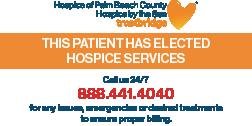
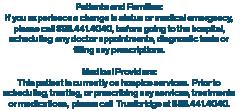
The card pictured above is included in your admissions packet. Please place this card with your insurance and/or identification card and present to any medical providers and suppliers prior to receiving services.
“ ” Not only did you take care of my mother’s physical needs, but you also provided psychological support for me, teaching and guiding me on how to better care for her and enabling me to become more confident in my abilities as a caregiver.
Important Information about Your Rights & Advance Care Planning
Insurance and Billing Information
The Medicare/Medicaid Hospice Benefit
Hospice patients are evaluated periodically to determine whether they continue to meet eligibility requirements. A patient who continues to meet hospice eligibility criteria may continue to receive our services, regardless of the length of time he or she has been under hospice care. A patient who no longer meets the criteria for continued reimbursement under the Hospice Medicare Benefit will be assisted by the hospice staff in reinstating regular Medicare Part A coverage. Should this occur, the hospice team ensures that the patient and family are included in the development and execution of a safe discharge plan. Patients with Medicaid are provided with the same services as those entitled to Medicare. A Medicare or Medicaid beneficiary can access only one of these Part A benefits at any given time.
Once on hospice, the hospice is in charge of your medical management and must be consulted prior to seeking any medical treatment/service, items, or drugs to determine if they are related to your terminal illness and related conditions, medically necessary, and/or part of the plan of care.
You may be financially responsible if you do not consult with the hospice prior to:
• Going to the emergency room/911
• Filling prescriptions at outside pharmacies
• Doctor’s visits/seeking treatment from non-hospice providers
It is the responsibility of the hospice staff to discuss patient/family goals of care and to decide if they are consistent with the hospice plan of care. Please let them know if you have any scheduled and/or upcoming doctor’s appointments, treatments, or other medical services being provided to you. Hospice staff will provide you with options so you can make an informed decision.
Note: Medicare patients who also have a Health Maintenance Organization (HMO) plan are entitled to the same services under Medicare as those individuals who are not affiliated with an HMO.
Private Insurance and HMOs
Most insurance plans provide a hospice benefit similar to Medicare. Hospice staff are available to assist in verifying insurance coverage for hospice services. Bear in mind, hospice coverage is for the life-limiting illness only. Any other illness or diagnosis not related to the life-limiting illness is handled under the patient’s regular insurance plan.
A patient may elect to stop hospice services at any time and return to regular Medicare Part A coverage.
Florida Patient Bill of Rights & Responsibilities
Florida law requires that your healthcare provider or healthcare facility recognize your rights while you are receiving medical care and that you respect the healthcare provider’s or healthcare facility’s right to expect certain behavior on the part of patients. You may request a copy of the full text of this law from your healthcare provider or healthcare facility. A summary of your rights and responsibilities follows:
1. A patient has the right to be treated with courtesy and respect, with appreciation of his or her individual dignity, and with protection of his or her need for privacy.
2. A patient has the right to a prompt and reasonable response to questions and requests.
3. A patient has the right to know who is providing medical services and who is responsible for his or her care.
4. A patient has the right to know what patient support services are available, including whether an interpreter is available if he or she does not speak English.
5. A patient has the right to bring any person of his or her choosing to the patient-accessible areas of the health care facility or provider’s office to accompany the patient while the patient is receiving inpatient or outpatient treatment or is consulting with his or her health care provider, unless doing so would risk the safety or health of the patient, other patients, or staff of the facility or office or cannot be reasonably accommodated by the facility or provider.
6. A patient has the right to know what rules and regulations apply to his or her conduct.
7. A patient has the right to be given, by the healthcare provider, information concerning diagnosis, planned course of treatment, alternatives, risks, and prognosis.
8. A patient has the right to refuse any treatment, except as otherwise provided by law.
9. A patient has the right to be given, upon request, full information and necessary counseling on the availability of known financial resources for his or her care.
10. A patient who is eligible for Medicare has the right to know, upon request and in advance of treatment, whether the healthcare provider or healthcare facility accepts the Medicare assignment rate.
11. A patient has the right to receive, upon request, prior to treatment, a reasonable estimate of charges for medical care.
12. A patient has the right to receive a copy of a reasonably clear and understandable itemized bill and, upon request, to have the charges explained.
13. A patient has the right to impartial access to medical treatment or accommodations, regardless of race, national origin, religion, physical handicap, or source of payment.
14. A patient has the right to treatment for any emergency medical condition that will deteriorate from failure to provide treatment.
15. A patient has the right to know if medical treatment is for purposes of experimental research and to give his or her consent or refusal to participate in such experimental research.
16. A patient has the right to express grievances regarding any violation of his or her rights, as stated in Florida law, through the grievance procedure of the healthcare provider or healthcare facility that served him or her and to the appropriate state licensing agency.
17. A patient is responsible for providing to the healthcare provider, to the best of his or her knowledge, accurate and complete information about present complaints, past illnesses, hospitalizations, medications, and other matters relating to his or her health.
18. A patient is responsible for reporting unexpected changes in his or her condition to the healthcare provider.
19. A patient is responsible for reporting to the healthcare provider whether he or she comprehends a contemplated course of action and what is expected of him or her.
20. A patient is responsible for following the treatment plan recommended by the healthcare provider.
21. A patient is responsible for keeping appointments and, when he or she is unable to do so for any reason, for notifying the healthcare provider or healthcare facility.
22. A patient is responsible for his or her actions if he or she refuses treatment or does not follow the healthcare provider’s instructions.
23. A patient is responsible for assuring that the financial obligations of his or her healthcare are fulfilled as promptly as possible.
24. A patient is responsible for following healthcare facility rules and regulations affecting patient care and conduct.
Medical Privacy Under the Health Insurance Portability and Accountability Act (HIPAA)
Trustbridge protects your medical information and your rights regarding your own medical records. We are dedicated to protecting your right to privacy of your medical information, while providing the highest quality medical care. We want you to be aware of regulations that affect how we use and disclose your medical information, and the rights you have regarding your medical records. Privacy rules adopted as part of the federal Health Insurance Portability and Accountability Act (HIPAA) establish standards for the release of medical information that personally identifies you.
Authorization/Release of Medical Records
Trustbridge is not allowed to discuss your care with anyone besides you and/or your legal representative unless you tell us it is okay to do so.
Requests for copies of your medical record require an authorization form to be filled out and signed by an authorized individual. While on service, authorized individuals include:
• The patient
• The patient’s legal representative (Healthcare Surrogate, Medical Power of Attorney, Proxy)
In Florida, hospice records have an extra layer of confidentiality to them and can only be released in certain circumstances once an individual is deceased. Those circumstances are:
• To the personal representative who has been appointed by the court
• To the executor/personal representative named in a Last Will & Testament, or
• By court order
No other individuals will be permitted to obtain copies of the medical record unless a valid authorization is on file. It is recommended that if you want anyone to have access to your medical records, you complete an authorization form while on service. You are not required to sign an authorization form and we will not deny treatment if you elect not to sign one.
Care Center Facility Directory
Our Care Center directory typically includes your name, location in the facility, and your general condition.
The Care Center may release this information, to inquiring family and friends, and in some circumstances to the media. You may restrict this disclosure by telling the Care Center you do not want that information released.
Trustbridge Notice of Privacy Practices
Empath Health offers a variety of services and programs in its continuum of care through its various subsidiaries and wholly controlled affiliated companies. This Notice of Privacy Practices applies to all of such services and programs including, but not limited to, Empath Partners in Care, Empath LIFE, Suncoast Hospice, Tidewell Hospice, Hospice of Marion County, Trustbridge, Hospice of Palm Beach County, Hospice by the Sea, Harbor Palliative Care Services, Empath Home Health, Empath Personal Care, Empath Therapies, Empath Community Health, Empath Grief Care, and Empath Medical Services. This joint Notice of Privacy Practices describes how Empath Health may use and disclose/share your health information and how you can get access to this information as defined in the Privacy Rule of the Administrative Simplification provisions of the Health Insurance Portability and Accountability Act of 1996 (HIPAA). Please review it carefully.
YOUR RIGHTS When it comes to your health information, under federal law, you have certain rights. This section explains what your rights are and some of our responsibilities to help you.
• You and/or your legal representative have the right to inspect and obtain a copy of your health information, including billing records. To see or obtain a copy, please contact the Health Information Management department.
Get an electronic or paper copy of your medical record
Ask us to correct your medical record
• Empath Health will make a reasonable effort to provide access to your protected health information in the form or producible in the form or format you request. Your record will be provided in either standard electronic format or if you do not want this form or format, a readable hard copy form.
• We will provide a copy of your health information within 30 days of your request. We may charge a reasonable, cost-based fee for copying, postage, labor and supplies.
• You and/or your legal representative have the right to request Empath Health to amend your records. You can ask us to correct health information about you that you think is incorrect or incomplete. To make this type of request, please submit your request in writing to the HIPAA Privacy Officer and explain why the amendment is necessary.
• We may say “no” to your request, but we’ll tell you why in writing within 30 days.
• You and/or your legal representative have the right to request confidential communications. Empath Health will not request that you provide any reasons for your request.
Request confidential communications
– Example: you can ask us to contact you in a specific way (for example, home or office phone) or to send mail to a different address.
• We will say “yes” to all reasonable requests.
• To make this type of request, please submit your request in writing to the HIPAA Privacy Officer.
• You and/or your legal representative have the right to request that Empath Health place additional restrictions on our use or disclosure of your health information. Empath Health is not required to agree to these additional restrictions, but if we do, we will abide by the agreement (except in emergency) or if it would affect your care.
Request restrictions, ask us to limit what we use or disclose
• In the event you pay out-of-pocket and in full for services rendered, you may request that Empath Health not disclose your health information with your health plan.
– We will say “yes” unless a law requires us to disclose that information.
• To request restrictions, you must make your request in writing to the HIPAA Privacy Officer. In your request, please include (1) the information that you want to restrict; (2) how you want to restrict the information (for example, restricting use to this office, only restricting disclosure to persons outside this office, or restricting both); and (3) to whom you want those restrictions to apply. Original Effective Date: April 14, 2003 | Effective Date of Last Revision: February 28, 2025
YOUR RIGHTS When it comes to your health information, under federal law, you have certain rights. This section explains what your rights are and some of our responsibilities to help you.
Get a list of those with whom we’ve disclosed information
• You and/or your legal representative can ask for a list (accounting) of the times we’ve disclosed your health information for up to six (6) years prior to the date you ask, who we disclosed it to, and why. To make this type of request, please submit your request in writing to the HIPAA Privacy Officer.
• We will include all the disclosures except for those relating to treatment, payment, and health care operations, and certain other disclosures (such as any you asked us to make). Empath Health will provide the first accounting you request during any 12-month period without charge. Subsequent accounting requests may be subject to a costbased fee.
Get a copy of this Privacy Notice
Choose someone to act for you
• You and/or your legal representative can ask for a paper copy of this Notice at any time, even if you have agreed to receive the Notice electronically. We will provide you with a paper copy promptly. You may also obtain a copy of the current version of Empath Health’s Notice of Privacy Practices at our website, EmpathHealth.org
• If you have given someone medical power of attorney, if someone is your health care surrogate or your legal guardian, that person can exercise your HIPAA rights and make choices about your health information.
• We will verify the person has this authority and can act for you before we take any action.
• You and/or your legal representative have the right to express complaints to Empath Health and to the Secretary of US Department of Health and Human Services, Office of Civil Rights, if you believe that your privacy rights have been violated.
File a complaint if you believe your rights are violated
Receive Notice of Breach of Protected Health Information
Additional Florida Privacy Protections
• You and/or your legal representative can contact Empath Health using the HIPAA Privacy Officer contact information listed at the end of this Notice. Empath Health encourages you to express any concerns you may have regarding the privacy of your health information and offers its assurance that you will not be retaliated against in any way for filing a complaint.
• You and/or your legal representative can file a complaint with the U.S. Department of Health and Human Services Office for Civil Rights by: sending a letter to 200 Independence Avenue, S.W., Washington, D.C. 20201, or calling 1-877-696-6775, or visiting hhs.gov/ocr/privacy/ hipaa/complaints/.
• We will not retaliate against you for filing a complaint.
• In the event of any unauthorized acquisition, access, use or disclosure of Protected Health Information, Empath Health will fully comply with HIPAA’s breach notification requirements, including any and all regulations that have been or may be promulgated, which will include notification to you of any impact that breach may have had on you.
• You and/or your legal representative have the right to any additional privacy protection granted through Florida law.
Original Effective Date: April 14, 2003 | Effective Date of Last Revision: February 28, 2025
YOUR CHOICES
In these cases, you have both the right and choice to tell us how you want to:
For certain health information, you can tell us your choices about what we disclose. If you have a preference for how we disclose your information in the situations described below, talk to us. Tell us what you want us to do, and we will follow your instructions. You may revoke your authorization in writing at any time except to the extent that Empath Health has taken action in reliance upon the authorization.
• Disclose information with your family, close friends, or others involved in your care. Empath Health may use or disclose health information to notify or assist in the notification of (including identifying or locating), your family member, your personal representative or another person responsible for your care, of your location, your
• general condition or your death. If you are present, then prior to use or disclosure of your health information, Empath Health will provide you with an opportunity to object to such uses or disclosures. In event of your incapacity or emergency circumstances, Empath Health will disclose health information based on a determination using its professional judgement disclosing only health information that is directly relevant to the person’s involvement in your health care.
• Include your information in a facility directory. If you are in an inpatient or residential facility, Empath Health may include in the directory your name, your general health status, your religious affiliation and your location while you are in the facility. Empath Health may disclose this information to people who ask for you by name. Please inform Empath Health if you do not want your information to be included in the directory.
• Coordinate appointment Reminders. Empath Health may use and disclose your health information to contact you as a reminder that you have an appointment for an upcoming visit.
• Educate you on treatment alternatives. Empath Health may use and disclose your health information to tell you about or recommend possible treatment options or alternatives that may be of interest to you.
• Participate in Health Information Exchange programs. If Empath Health participates in HIE to allow timely and secure sharing of your information with other health care providers, health care companies, or their business associates as permitted by law, you will have a chance to opt-in to participate in the HIE. HIE programs can provide faster access, better coordination of care and assist providers and public health officials in making more informed decisions about your care.
In these cases we never disclose your information unless you give us written permission:
In the case of fundraising
• Marketing purposes
• Sale of your information
• Sensitive information such as: HIV and AIDS, psychotherapy, and alcohol/drug notes.
• Empath Health may use information about you including your name, address, phone number and the dates you received care in order to contact you or your family to raise money for Empath Health. Empath Health may also release this information to affiliated foundations. If you do not want Empath Health to contact you or your family, you should notify the HIPAA Privacy Officer.
Original Effective Date: April 14, 2003 | Effective Date of Last Revision: February 28, 2025
OUR USES AND DISCLOSURES
How do we typically use or disclose your health information? We typically use or disclose your health information in the following ways.
To Provide Treatment
To Conduct Health Care Operations
To Obtain Payment
• We may use your health information to coordinate treatment with others involved in your care, such as your physician, members of the care team and other health care professionals who assist in providing care. Empath Health also may disclose your health care information to individuals outside the organization who are involved in your care including family members, clergy who you have designated, pharmacists, suppliers of medical equipment, or other health care professionals.
• Example: physicians involved in your care will need information about your symptoms in order to prescribe appropriate medications.
• Empath Health may use and disclose health information for our own operations in order to facilitate functions and, as necessary, to provide quality care to all.
– Example: Empath Health may use or disclose your health information to perform quality assessment activities or evaluate the performance of our staff and services.
• Empath Health may use and disclose your health information to obtain payment for services we provide to you, unless you request that we restrict such disclosures to your health plan when you have paid out-of-pocket and in full for services rendered.
– Example: We give information about you to your health insurance plan so it will pay for your services.
How else can we use or disclose your health information? We are allowed or required to disclose your information in other ways, usually in ways that contribute to the good of the pubic. We have to abide by the law and meet certain conditions before we can disclose your information for these purposes.
Help with public health and safety issues
Research
Comply with the law
Respond to organ and tissue donation requests
• Empath Health may, consistent with applicable law and ethical standards of conduct, disclose your health information if Empath Health, in good faith, believes that such disclosure is necessary to prevent or lessen a serious and imminent threat to your health or safety, or to the health and safety of the public. We can disclose health information about you for certain situations such as:
– Reporting communicable diseases
– Helping with product recalls
– Reporting adverse reactions to medications
– Reporting suspected abuse, neglect or domestic violence
• Empath Health may, under very select circumstances, use your health information for research. Before Empath Health discloses any of your health information for such research purposes, the project will be subject to an extensive approval process.
• Empath Health will disclose your health information when it is required to do so by any Federal, State or local law.
• In the event you have chosen to be a donor, Empath Health may use or disclose your health information to organ procurement organizations or other entities engaged in the procurement, banking or transplantation of organs, eyes or tissue for the purpose of facilitating the donation and transplantation.
OUR USES AND DISCLOSURES
How do we typically use or disclose your health information? We typically use or disclose your health information in the following ways.
• Empath Health may disclose your health information to coroners and medical examiners for purposes of determining your cause of death or for other duties, as authorized by law.
Work with a medical examiner or funeral director
Workers’ compensation and other government requests
• Empath Health may disclose your health information to funeral directors consistent with applicable law and if necessary, to carry out their duties with respect to your funeral arrangements. Empath Health may disclose your health information to funeral directors prior to and in reasonable anticipation of your death, if deemed necessary to fulfill their duties.
• Empath Health can use or disclose health information about you:
– For workers’ compensation or similar programs
– With health oversight agencies for activities including audits, civil administrative or criminal investigations, inspections, licensure or disciplinary action.
– For law enforcement purposes, as authorized by Federal, State or local law.
– For special government functions such as to military and veterans, national security and intelligence activities, protective services for the President and others, medical suitability determinations and inmates and law enforcement custody.
Judicial and Administrative Proceedings
Law Enforcement
• Empath Health may disclose your health information in the course of any judicial or administrative proceeding, in response to court or administrative order or in response to a subpoena, discovery request or other lawful process, but only when Empath Health makes reasonable efforts to either notify you about the request or to obtain an order protecting your health information.
• As permitted or required by State Law, Empath Health may disclose your health information to a law enforcement official for certain law enforcement purposes such as:
– Required by law for reporting of certain types of wounds or other physical injuries pursuant to the court order, warrant, subpoena or similar process.
– For the purpose of identifying or locating a suspect, fugitive, material witness or missing person.
– Under certain limited circumstances, when you are or are suspected to be the victim of a crime.
– To a law enforcement official if Empath Health has a suspicion that your death was the result of criminal conduct, including criminal conduct at Empath Health.
– In an emergency in order to report a crime on the premises.
Business Associates
• Empath Health may disclose your health information with third-party “business associates” that perform various activities (e.g., billing, transcription services) for Empath Health. Whenever an arrangement between Empath Health and a business associate involves the use or disclosure of your health information, Empath Health will have a written contract that contains terms that will protect the privacy of your health information.
Our Responsibilities
• Empath Health is required by law to maintain the privacy of your health information and to provide this Notice of its duties and privacy practices to you or your authorized representative.
• Empath Health will let you know promptly if a breach occurs that may have compromised the privacy or security of your health information.
• Empath Health is required to abide by the terms of this Notice and give you a copy of it.
• Empath Health will not use or disclose your information other than as described here, unless you tell us we can in writing. If you tell us we can, you may change your mind at any time. Let us know if you change your mind by contacting the Privacy Officer in writing.
Changes to the Terms of this Notice
Empath Health reserves the right to change the terms of its Notice and to make the new Notice provisions effective for all health information that it maintains. If Empath Health makes material changes to its Notice, Empath Health will make a copy of the revised Notice available to you or your authorized representative. The new Notice will be available upon request in our office and on our website.
Additional Notice
A court order may be required pursuant to Florida Statute Section 400.611(3) before Empath Health will release your records after your death, unless during your life you (or your authorized representative) expressly state in writing that a specific person or entity is authorized, after your death, to request and receive your health information.
Privacy Official Contact Information
Amanda Tippin, HIPAA Privacy Officer 5300 East Ave. West Palm Beach, FL 33407 (561) 227-5123 atippin@trustbridge.com EmpathHealth.org
Original Effective Date: April 14, 2003
Effective Date of Last Revision: June 29, 2018[TAL1]
Advance Decision Making
Advance Directives Policy Summary [TAL2]
It is the policy of Trustbridge and its entities to acknowledge and honor the rights and wishes of all patients and authorized representatives to make healthcare decisions about medical care, treatment, or services received or refused at the end of life in accordance with law and regulations. No patient may be denied services from the Organization solely on the basis of whether or not the patient has formulated an Advance Directive, provided his or her personal goals and philosophy of treatment are within the confines of the law. You are not required to have a Do Not Resuscitate order to receive hospice services.
• The patient has the right under the law to make decisions regarding his/her healthcare.
• The patient has the right under the law to make Advance Directives.
• The Organization will honor the patient’s decisions within the limits of the law.
• The Organization will ensure the patient’s wishes are communicated to all caregivers.
• Any identified risk issues or questionable documents shall be reviewed prior to implementation. If Trustbridge is unable to implement an Advance Directive(s), the reason why will be provided in writing to the patient and/or legal representative.
Implementation of Advance Directives: All Advance Directives and legal documents must be fully executed (documents are completed with signatures, dates and appropriate court stamps as applicable) in order for the Organization to honor and follow the tenets and language in the documents. Copies of the Advance Directives/legal documents are required in the patient’s medical record.
Changes to Advance Directives: Advance Directives may be revoked or amended by the mentally competent patient at any time, and documentation of these changes must be obtained and placed in the clinical record. It is the responsibility of the patient and/or family to inform the Organization of changes to the Advance Directives, which allows the medical record to reflect the current wishes of the patient and family.
More information is available from Trustbridge in our booklet, My Life Choices.
Reporting Customer Concerns/Complaints
Trustbridge is fully committed to excellent customer service, both in principle and as a matter of policy. This policy is consistent with the mission, vision and values set forth by the Organization. Trustbridge will, in a timely manner, address, review, and resolve all customer concerns and complaints.
If you experience a service performance that fails to meet your expectations, Trustbridge and its affiliates welcomes the opportunity to discuss the concern and achieve a resolution. We greatly appreciate your feedback, as it allows us to research, educate our staff, and ultimately improve our processes.
Concerns or complaints may be reported to us via:
• Conversation with a Trustbridge employee
• Posting to website: www.trustbridge.com (contact us anytime)
• Telephone: Patient Advocate Line 1.844.226.7313
• Letters: Patient Advocate Trustbridge, Inc. 5300 East Avenue West Palm Beach, FL 33407
• Comments submitted on the Consumer Assessment of Healthcare Providers and Systems (CAHPS) survey OR
• Comments submitted on the Evaluation of Grief Suppport Services (EGSS) survey
If you believe your feedback was not adequately addressed internally by our Organization, Trustbridge, you may also express your concerns to The Joint Commission or the State of Florida.
Reporting Agencies
In the event you have already contacted our Organization and we have not adequately addressed your concerns, you may also choose to contact the agencies listed below.
The Joint Commission
Our Organization is accredited by The Joint Commission on Accreditation of Healthcare Organizations. Accreditation by this regulatory Agency means compliance and adherence to the highest possible standards of quality care.
We encourage patients and families to share concerns with their hospice teams or any administrative personnel to ensure resolution of concerns and issues. The Organization provides a problem-solving procedure. We seek to resolve concerns fairly, equitably and within a reasonable time frame.
If you wish to make any comments to The Joint Commission on Accreditation of Healthcare Organizations, they may be contacted:
• Online: http://www.jointcommission.org
• E-mail: complaint@jointcommission.org
• Phone: 630-792-5800 or Fax: 630-792-5636 (Mon.-Fri., 8 a.m. - 5 p.m.)
• Mail: Office of Quality and Patient Safety
The Joint Commission One Renaissance Boulevard Oakbrook Terrace, IL 60181
The Joint Commission conducts periodic unannounced surveys during the course of the accreditation cycle. We desire to keep our patients and families informed of these important evaluations; however, we never know the exact date when the survey will occur.
Florida Agency for Health Care Administration Hotline
We are licensed by the Agency for Health Care Administration. The Division of Health Quality Assurance protects Floridians through oversight of health care providers. Health Quality Assurance licenses and/ or certifies and regulates 40 different types of healthcare providers, including hospitals, nursing homes, assisted living facilities, and home health agencies. To file a healthcare facility complaint: Call Toll Free: 1-888-419-3456 (Mon. - Fri., 8 a.m. - 6 p.m.) or http://ahca.myflorida.com
Medicaid Fraud and Reporting Abuse
Medicaid fraud means “an intentional deception or misrepresentation made with the knowledge that the deception could result in some unauthorized benefit to him/herself or another person.” It includes any act that constitutes fraud under applicable federal or state law as is related to Medicaid. To report any suspected fraudulent behavior or suspected abuse with the Medicaid program: Call Toll Free: 1-888-419-3456 (Mon. - Fri., 8 a.m. - 6 p.m.) or http://ahca.myflorida.com
Abuse can come in many forms, such as: physical or verbal maltreatment, injury, sexual assault, violation, rape, unjust practices, wrongful practice or custom, offense, crime, or verbal aggression. To report any suspected abuse: Call Abuse Hotline: 1-800-962-2873 or 1-800-96-ABUSE (24 hours/7 days)
Colleague Support Statement
Empath Health is proud to deliver extraordinary Full Life Care for All through our dedicated staff and volunteers. Their ability to work in a safe environment is important to us and them. Empath Health is committed to supporting a workplace free from unlawful discrimination and harassment. If patients, caregivers, clients, and/or participants display discriminatory or harassing actions or words, it will be addressed by the appropriate department leader.
Solutions may include the patient, client or participant being discharged or unenrolled from their Empath Health program.
Our President and CEO and Executive Team Leaders are committed to supporting Empath Health’s colleagues and volunteers, to Empath Health being an employer of choice for its colleagues, and to living Empath Health’s core values while achieving its mission and vision.
Hospice Care Training: Symptom Management & Medications
In this section, you will find information to help manage your loved one’s symptoms and maximize their comfort.
Your Trustbridge Pharmacy
Hours of operation: 7 a.m. to 11 p.m. daily, including holidays
Medication Refills
You can request prescription refills through our automated phone system. Please call our Pharmacy Refill Line at 844.728.5930. To request refills:
• Refills shoud be requested five (5) days before running out of medicine.
• Have the prescription number(s) available before calling.
• Please allow up to two (2) days for delivery.
Medication Delivery
Medications determined to be related to your hospice diagnosis will be delivered by courier to your door. If you have any questions or concerns regarding your medication – usage, potential side effects, or storage – call 1.844.728.5930.
Patient Medication Information
Each medication ordered for you by your doctor will be accompanied by a patient medication information sheet. This sheet will contain information on how to safely use each drug prescribed, including how to take the medicine, when to take it, and common side effects associated with taking the medicine.
The Comfort Kit*
About the Comfort Kit
The Comfort Kit contains commonly used medications to manage urgent symptoms. Each medicine is to be taken according to the directions on the prescription label and those provided by the nurse or prescriber. Medicines in the Comfort Kit should only be taken when the patient is instructed to do so by the nurse or prescriber. The nurse or prescriber will provide information on which medicine to take, when to take it and how long to take it. Please notify the nurse if any of the medications in the Comfort Kit are used.
Comfort
Kit Storage
Keep the Comfort Kit and contents in a secure place out of the reach of children, as the Comfort Kit is not childproof.
Do not store in the bathroom, in heat or light.
Precautions
Inform the nurse or doctor if the patient is allergic to any medications in the Comfort Kit, or similar medications as those contained in the Kit.
Notify the nurse or prescriber if symptoms do not improve or become worse. Medicines in the Comfort Kit may cause dizziness, drowsiness or make it hard to concentrate. To avoid feeling light-headed, the patient should get up slowly from sitting or lying down. Do not attempt tasks requiring alertness while taking medicines from the Comfort Kit.
nurse is available by phone 24 hours a day. Just call 1-888-441-4040.
Do not share medicine with anyone other than the person for whom it was prescribed. Inform nurse or prescriber about other medicines, herbs, alcohol, or over-the-counter medicines the patient is taking before the medicines are used. This information does not replace the need to follow your physician’s instructions and the need to read the drug information leaflet provided with your prescription(s).
Pain Management
DEFINITION
*Adapted with permission from Enclara Pharmacia 2017
PAIN is subjective (personal). It is whatever the person says it is. Every individual has a different pain tolerance.
Pain can be both a physical sensation and an emotional experience. Only the person experiencing it can describe pain, its intensity, the pain sensation and the effectiveness of pain relief measures.
When a person can’t express pain verbally we rely on non-verbal indicators of pain such as facial and body expressions.
There may be many causes for pain or discomfort, such as:
• Cancer (primary or metastatic).
CAUSES
• Inflammation of joints or other areas of the body.
• Muscle spasms.
• Damage to organs or nerves as a result of an illness or injury.
REPORTING/ ASSESSING PAIN
• If the person can report pain – ask the following:
• How severe is the pain based on a scale of zero being equal to no pain and 10 being the worst pain imaginable?
• Where is the pain located?
• What does the pain feel like?
• What makes the pain better or worse?
• How well is the pain medication or other intervention working?
• Non-verbal indicators of pain include some of the following:
• Facial grimacing; frowning.
• Teary eyes; crying.
• Wincing; rubbing; bracing.
• Restlessness.
• Vocal complaints such as moaning, groaning, or yelling.
COMMONLY USED OPIOID (NARCOTIC) PAIN MEDICATIONS
The following are opioids (narcotics) commonly used to treat pain:
• Morphine Sulfate IR (immediate release MSIR).
• Morphine Sulfate ER (extended release MS Contin).
• Oxycodone IR (immediate release – Oxy IR).
• Oxycodone ER (extended release – Oxycontin).
• Fentanyl topical (Duragesic patch) (see special instructions for more information on this medication).
• Hydromorphone (Dilaudid).
• Methadone (see special instructions for more information on this medication).
• Hydrocodone and acetaminophen (Vicodin or Lortab).
• Hydrocodone and ibuprofen (Vicoprofen).
• Oxycodone and acetaminophen (Percocet).
Ningún Dolor Pa gen doulé di tou
Dolor moderado Y on doulé ki pa tro fo
Dolor peor posible Y on doulé pi fó anpil
Hurts Little Bit Hurts Little More
Hurts Even More Hurts Whole Lot Hurts Worst
MYTHS ABOUT PAIN MEDICATIONS
Addiction: Today we see a great deal of focus in the media on opioid (narcotic) addiction. As a result, some people are concerned about the use of opioids for the treatment of pain and that they may become “addicted” to pain medication. Opioid addiction is a pattern of psychological desire to obtain and use a drug for its effects on the mind. (“To get high.”) Ask yourself, “If I didn’t have pain, would I be taking this medication?” Most likely the answer would be “No.”
If strong pain medication is used early it will prevent good pain relief when it is really needed in the future: Pain medication administered correctly does not stop working with time. As the disease progresses it may be necessary to change the pain medication or the dose. This does not indicate addiction but rather a natural progression of the disease.
Once a person is on morphine death is near or morphine hastens death: Morphine and other opioids do not hasten death, nor do they prolong life. Morphine does not cause death, the underlying illness does.
Pain is part of illness: Some people report less pain than they are actually experiencing because they believe that pain and illness go hand-in-hand and must be tolerated. Not all people with life-limiting illnesses experience pain. Uncontrolled pain can prevent a person from enjoying a better quality of life and may make other symptoms worse.
Injections are better than oral medication: Injections are only necessary if a person can’t take oral medication. Oral preparations are effective. Long-acting oral forms mean better pain control and less frequent administration.
Side effects (nausea, vomiting, constipation, etc.) are allergies: True allergies to morphine and other opioids are rare. Side effects can be managed.
COMMON SIDE EFFECTS OF PAIN MEDICATION
1. Constipation: All opioids cause constipation. For this reason, taking a laxative along with an opioid is generally recommended.
2. Nausea/vomiting: These symptoms usually subside after a few days. Your physician may have ordered a medication to relieve these symptoms. If not, contact Trustbridge immediately.
3. Dry mouth:
• Eat popsicles, shakes, yogurts, lemon drops and/or ice chips.
• Increase fluid intake, as much as tolerated.
• Rinse mouth frequently. Use mouthwash sparingly and use ONLY mouthwash labeled for “dry mouth.”
• If dryness is severe, ask your nurse for artificial saliva.
4. Sedation or drowsiness: Drowsiness is the body’s way of re-energizing and resting from the strain that pain has placed on your body. If the drowsiness does not subside within a few days, contact Trustbridge. Caffeinated drinks such as coffee or tea can be used to minimize sedation.
5. Dizziness: When starting on opioids or whenever increasing the dose, be aware that you may experience dizziness when getting out of bed, out of a chair or when participating in any strenuous activity.
• Move more slowly when getting out of bed or up from a chair.
• Allow your feet to dangle at the side of the bed or chair before attempting to rise.
• Call for assistance when needed.
• Avoid strenuous activities such as driving, cleaning or cooking.
• Make sure your home environment is safe from scatter rugs and loose cords, and keep the area well lit.
6. Itching: Itching may occur for up to 3 days when a dose is started or increased.
7. Contact Trustbridge immediately if there is a sudden onset of severe sedation, rash/hives or any other serious effects or symptoms that concerns you related to your medication.
1. The goal of pain management is for the person to be alert while pain is kept under control.
2. Pain is cumulative. The best approach is taking pain medication on a regular, around-the-clock schedule rather than simply as needed. If you wait too long to take your pain medication, the pain can become so severe that the medication is no longer effective.
GENERAL GUIDELINES FOR PAIN MANAGEMENT
3. Once you are pain-free, it is important to continue the medication schedule as directed by your physician. Different pain medications are effective for different lengths of time. Taking medication at the appropriate intervals is very important.
4. Accurate record-keeping regarding the time of day you take your pain medications and the level of relief you experienced will help your hospice team to better manage your pain control needs.
5. Do NOT crush long-acting oral pain medications. If you are unable to swallow or have difficulty swallowing, contact Trustbridge and a different medication or different route of administration may be ordered.
by phone 24 hours a day. Just call 1-888-441-4040.
WHEN TO TAKE MORE PAIN MEDICATION
AROUND-THE-CLOCK DOSES
The best way to manage pain is to control it with a regular around-the-clock schedule of medication that allows the person to be comfortable and alert. There are two ways to manage around-the-clock dosing.
The physician may order:
A. Long-acting opioid to be given every 8, 12 or 24 hours around-the-clock. OR
B. Short-acting opioid to be given every few hours around the clock.
AS NEEDED DOSES
(Also known as “Breakthrough” or “Rescue Doses”)
There may be periods of time when pain increases due to activity, disease progression or need for change in the amount of around-the-clock medication. For this reason physicians commonly order “as needed” doses of short-acting opioid.
1. If you are taking your regular around-the-clock pain medication and you are having pain, you may also take your “as needed” pain medication.
2. These “as needed” pain medications or “as needed” doses of the same pain medication are often ordered to be available every 1 or 2 hours when discomfort/ pain is at an uncomfortable level.
3. You may take this “as needed” (rescue dose) medication at the same time as you take your regularly scheduled dose or at any time in between your regular around-the-clock dose. It will not cause you to “overdose.”
4. You should always take your around-the-clock doses, but the “as needed” doses are to provide short-term relief for those times when your around-the-clock medication is not enough to treat the pain you are experiencing.
5. You may use the “as needed” doses as frequently or infrequently as necessary for your comfort as long as you follow the directions for amount and time interval your physician ordered.
6. Your accurate record-keeping is very important and helpful. Your nurse and physician will review your pain monitoring flow sheet to assess the need for any pain medication changes
1. Distraction or diversion: Many people with chronic pain report that concentrating on something other than pain may help. Some things to try are watching TV or movies, reading, listening to music, writing, painting or other activities that you enjoy.
THINGS YOU CAN DO NOW FOR THE PERSON
2. Meditation and relaxation: Meditation and breathing exercises may help reduce muscle tension. Many libraries have meditation CDs available for loan. Other options are prayer, visualization and/or focused deep breathing.
3. Massage: Gentle massage, body rubs or simply a soft touch can be soothing.
4. Take your medication, as ordered: Keep a record of each dose taken and your pain rating (response to medication) 1 hour after your administration of the medication.
5. Notify Trustbridge if your pain is not relieved or gets worse.
by phone 24 hours a day. Just call 1-888-441-4040.
THINGS TO DO WITH PHYSICIAN APPROVAL
o Moist Heat Pack: Moist heat promotes muscle relaxation, relieves muscle spasms and increases blood flow to the area.
• Materials Needed: 1 large Ziploc freezer bag, 1 large bath towel and 1 small towel.
• Procedure:
• Run warm tap water over the small towel and wring it out.
• Fold towel and place in OPEN Ziploc bag. (Do NOT close bag.)
• Place bag in microwave oven and run on high for 1 - 2 minutes.
• CAREFULLY remove VERY HOT towel pack from microwave oven, keeping steam away from face and avoiding burning yourself. Seal the Ziploc bag.
• Wrap hot towel pack with the large dry towel to prevent burns when placing on body part.
• Place towel-wrapped pack on affected / painful body area. An additional towel or blanket may be placed on top to keep the area as warm as possible.
• Leave on body a maximum of 20 – 30 minutes at a time.
o Slush Cold Pack: Cold decreases pain and decreases swelling.
• Materials Needed: 1 large Ziploc freezer bag, rubbing alcohol, water, 1 large bath towel and 1 small towel.
• Procedure
• Mix 3 cups water and 1 cup alcohol in Ziploc bag.
• Remove as much air as possible and seal bag.
• Place mixture overnight in freezer.
• Place towel between body part and pack to allow skin to adjust to the cold gradually.
• Conform cold pack to shape of body area and cover with an additional towel.
• The cold will not freeze skin when properly applied.
• Leave in place to comfort the patient, maximum time 10 – 15 minutes.
Using the Morphine Oral Syringe
Morphine Sulfate Oral Solution; 100mg/5mL (20mg/mL); 1mL Oral Syringe
Steps to Follow
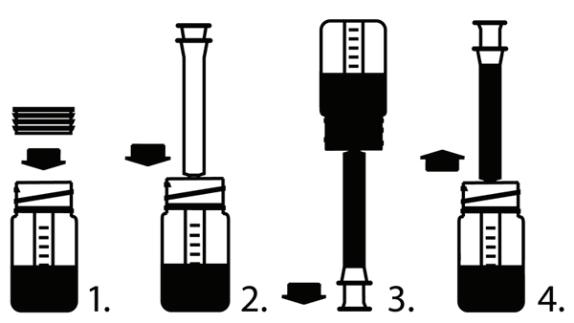
1. Insert bottle plug into neck of the bottle, ribbed end first.
2. Insert syringe tip into hole on the top of the plug until secure.
3. Turn bottle upside down and pull down white syringe plunger to the line that matches the dose prescribed by your doctor.
4. Turn the bottle right side up. Remove syringe by twisting.

Plunger Measure the dose from the widest portion of the plunger
Do NOT measure to narrow top of plunger
Additional Tips
• Always use the oral syringe provided to make sure you measure the right amount.
• Common doses include:
• 5mg (0.25mL)
• 10mg (0.5mL)
• 15mg (0.75mL)
• 20mg (1mL)
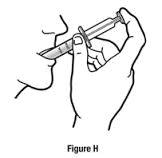
Steps Continued
5. Put the tip of the syringe into your mouth.
6. Take the medicine by slowly pushing the plunger until the syringe is empty.
7. Once medication has been administered, rinse syringe with water.
8. Leave the plug in the bottle. Recap the bottle tightly with the supplied cap.
Drug Specific Information
Fentanyl Patch for Pain Management
About Fentanyl Patch
Fentanyl is an opioid skin patch used for the management of persistent moderate to severe pain.
• Brand names Duragesic®
• It is prescribed for people who are already using an oral opioid for pain relief.
How It Works
• After the fentanyl patch is applied, the medication passes through the skin into the “fat layer” of the skin and from there is absorbed into the body.
• A certain amount of medication must build up in the skin before enough medication to provide pain relief is absorbed into the body.
• It may take 12 to 24 hours before the first dose of fentanyl begins to work.
• You may need to take a fast-acting oral opioid by mouth to relieve pain while your fentanyl dose is adjusted.
• Patches are changed every 72 hours (or 48 hours) as prescribed by your doctor.
• There is still medication in the patch that is going into your body when it is time for the patch to be changed. But it is estimated that the amount of medication remaining in the patch may not be enough to fully manage your pain after 72 hours.
How To Apply the Patch
Fentanyl patches are applied to the skin. It is important that they be applied correctly for the medication to be properly absorbed into your skin.
• Where to apply the patch
• Patch may be applied on a flat area of the chest, back or upper arm.
• If you are placing the patch on someone who has decreased mental alertness (is confused or becomes agitated) choose a site on the back.
• Do NOT apply directly over a bone, such as your collar bone. The medication works best if there is some “fatty tissue” under the skin.
• Choose a place where the skin is not very oily and, is free of scars, cuts or burns.
• Application
• If need be, clean the skin with water. Do NOT use any soap, cleaners, lotions, or anything that contains oils or alcohol. Allow to dry thoroughly.
• The patch will stay in place better if it is applied to an area with little or no hair. If necessary you may clip hair with scissors but do NOT shave it off.
• Remove the liner covering the sticky side of the skin patch. (Be careful to avoid touching the side that goes against the skin.)
• Press the patch firmly in place with the palm of your hand and hold for at least 30 seconds.
• Make sure the entire adhesive surface is attached to the skin (especially the edges).
• Wash your hands with soap and water.
• If you have difficulty with the patch sticking
• First-aid tape may be applied on ONLY the edges of the patch. Do NOT tape over the entire patch.
• If it falls off after application, dispose of the patch (see Safety Training: Safe disposal of medications) and apply a new one.
by phone 24 hours a day. Just call 1-888-441-4040.
• Re-application
• Follow the doctor’s instructions about how frequently to apply a new patch.
• Generally patches are changed every 72 hours (3 days).
• Remove old patch before applying new patch as old patches still contain some medication (see page 55).
• Choose a new site and follow the application procedure.
• Safe Handling
• Do not cut or use damaged patches. If patch leaks gel, thoroughly wash affected skin with lots of water (no soap) and contact nurse.
• Used patches still contain active medicine and pose a danger to others.
• Store patches in an area where temperature does not exceed 77°F.
• Safe Application
• Do not use more patches than prescribed. Remove old patch before applying new patch.
• Avoid heat on the site of the patch (excessive sun exposure, saunas, hot tubs, heating pad, electric blankets, etc.). The body may absorb too much medication with excessive heat.
• Avoid tight covering over the site of the patch.
• Call Trustbridge right away for a fever higher than 102ºF. Fever can result in the medication being absorbed more rapidly than ordered.
What if I Forget to Change the Patch or Change it too Soon?
• Missed dose – forgot to change the patch.
• Put a new one on as soon as you can.
• Do NOT put extra patches on to make up for the dose.
• Let Trustbridge know. You may still be receiving some benefit of medication remaining in the patch but the dose may not be as high as necessary to manage your pain. You may need to have a fast acting oral opioid available for immediate pain relief.
• Changed the patch too soon.
• Changing the patch too soon will not cause an overdose.
• Changing the patch earlier will not provide more pain relief.
• Let Trustbridge know. It may mean that your fentanyl will need to be refilled sooner.
• Forgot to take the old patch off – wearing multiple patches.
• Call Trustbridge 1.888.441.4040.
• Look for signs of sedation or any of the side effects listed below.
Side Effects
• Common side effects are the same as for other opioids. See previous pages.
• Contact Trustbridge immediately if you experience any of the following:
• Trouble breathing or very slow breathing.
• Significant dizziness, faintness or confusion.
• Slow or rapid heartbeat.
• Bad headache.
• Chest pain.
• Swelling of arms or legs or unusual weight gain.
nurse is available by phone 24 hours a day. Just call 1-888-441-4040.
Food and Drug Interactions
• Do not eat grapefruit or drink grapefruit juice while on this medication.
• Make sure you alert your nurse if you make any changes in your prescription medications or if you have added any new herbals, vitamins or over-the-counter medications, including the consumption of alcohol.
Safety Precautions
• Child and Pet Safety concerns.
• Store patches safely and away from children and pets.
• Do not let children see you apply the patch.
• Do not refer to the patch as a sticker. This may encourage children to mimic your actions.
• Do not apply on areas of your body where children can see it. Children have removed patches from adults and put them in their mouths or on their bodies, with deadly results.
• If a patch is chewed, sucked on or ingested seek immediate medical attention.
Discarding Used Patches: Used patches still contain active medication. Protect others by disposing of any used patches safely by folding the sticky sides together and flushing patch down the toilet immediately. USED patches are the only exception to the safe medication-disposal rule. They should be destroyed by flushing down the toilet. Do NOT put them in the trash.









Methadone for Pain Management
About Methadone
Methadone is used to relieve severe pain. Brand names include Dolophine® and Methadose®.
• It can take approximately 1 week before the full pain relief effect is reached.
• Do NOT take extra doses of methadone unless prescribed by your doctor. This can increase side effects and can cause methadone toxicity.
• If you are still in pain after taking your medications, contact Trustbridge at 1.888.441.4040.
Administration
• Methadone should be taken exactly as prescribed by your doctor.
• Tablets may be crushed if you are unable to swallow. The crushed tablet may be placed in applesauce to assist with swallowing.
• If you are prescribed liquid methadone oral solution, use the measuring device provided to accurately measure out your prescribed dose (do not use household spoons).
• If you miss a dose, do NOT double up on doses. Contact your nurse on how to continue your medication.
Side Effects
• Common side effects are the same as other opioids. See previous pages.
• Contact Trustbridge immediately if you experience any of the following:
• Difficult or slow breathing.
• Trouble staying awake.
• Fast heartbeat.
• Unusual or extreme dizziness or loss of consciousness.
• Excessive sleepiness or difficulty being awakened.
• Loud or unusual snoring (not your typical sleeping habits).
• Signs of allergic reaction: rash, hives, swelling.
Food and Drug Interactions
• Methadone does interact with certain prescription medications, over-the-counter medications and vitamin/herbal supplements. These interactions can lead to increased side effects and potential toxicity.
• It is important to provide your nurse with a complete list of all your medications, including if you plan on stopping, changing or adding any new medications.
Safety Precautions
• Methadone should always be stored in a safe place out of the reach of children.
• Do not store methadone out in the open (kitchen counter, bathroom or obvious places).
• A single dose of methadone can be very harmful to an individual who is not used to it.
phone 24 hours a day. Just call 1-888-441-4040.
Restlessness / Agitation
RESTLESSNESS: An inability to rest, relax or concentrate.
DEFINITION
AGITATION: Extreme restlessness.
Restlessness and/or agitation may be observed in the hours or days before death.
• Restlessness.
• Fidgeting, moving around without a known reason.
SIGNS AND SYMPTOMS
THINGS YOU CAN DO NOW FOR THE PERSON
• Sleeplessness.
• Inability to concentrate.
• Inability to get comfortable.
1. Offer frequent reassurance.
2. Relaxation:
• Trying to get out of bed for no known reason.
• Muscle twitching.
• Grimacing.
• Pulling or picking at sheets, covers, or clothing.
• Keep the environment quiet – play calming music.
• Decrease the number of visitors.
• Read favorite stories, poems, etc., in a calm voice.
• Offer prayer or meditation, if appropriate to person’s beliefs.
• Hold the person’s hand.
• Hand or foot massage may be helpful.
3. Keep the person safe. If the person is getting out of bed, do not leave him/her alone.
4. Take/administer medications as ordered.
5. Notify Trustbridge if restlessness/agitation is not relieved, is new or worsening.
Sometimes agitation is a response to physical discomfort. Before calling Trustbridge it would be helpful if you were able to gather the following information to give to the nurse.
• Is this new or sudden behavior?
• Is the agitation increasing in severity and duration?
• Is the person constipated? When was the person’s last bowel movement? Can you describe it?
• When was the last time the person urinated? (Had a wet diaper or passed urine?)
• Is the person drinking fluids?
• Is the person having difficulty swallowing? Able to take medications?
• Is the person receiving any new medication? Any medication for agitation? If so, what medication and when was the last dose?
Trouble Breathing/Shortness of Breath
DEFINITION
CAUSES
BREATHING DIFFICULTY / SHORTNESS OF BREATH is a subjective (personal), uncomfortable awareness of breathing. It may be described as not getting enough air (a feeling that you can’t catch your breath, like the room is closing in or that there is not enough air in the room).
Shortness of breath is not necessarily connected to a person’s appearance or to a low oxygen level. The medical term used for this is dyspnea.
There may be many causes for breathing difficulties, such as:
• Diseases that affect the lungs or cardiac system.
• Fluid buildup in the cavities near the lungs that pushes against the lungs.
• Natural changes in the brain chemistry at end of life leading to various breathingpattern changes.
Regardless of the cause, shortness of breath often causes anxiety and anxiety increases the oxygen demands of the body, which makes shortness of breath worse. Treating both the shortness of breath and anxiety helps to relieve symptoms.
• Feeling “winded” or unable to speak in full sentences.
• Sitting with hands on knees, or on the side of the bed, leaning over bedside table to breathe.
SIGNS AND SYMPTOMS
THINGS YOU CAN DO NOW FOR THE PERSON
• Using neck, shoulder, chest and abdominal muscles to breathe.
• Feelings of anxiety or fear. May appear stressed, anxious and frightened.
• Lips and nail beds may be bluish in color and extremities may be cool and/or “mottled.”
• Position is important.
• Sit in a chair or a recliner. If able, try sitting up and leaning forward over a table or leaning forward with hands on knees.
• While lying in bed, elevate your head on pillows or raise the head of an electric bed.
• Keep room cool. Use air conditioning rather than open windows and doors.
• Increase air movement. Direct a fan to gently blow across cheek.
• Apply a cool cloth to head or neck.
• Relax.
• Keep the environment quiet – try calming music.
• Use relaxing activities such as prayer or meditation.
• Hand or foot massage may be helpful.
• Pursed-lipped breathing: Take slow, deep breaths: Breathe in through nose and then breathe out slowly and gently through “puckered” lips (as if you were going to whistle). Exhale should take longer than inhale.
• Take medications as ordered.
Notify Trustbridge if your shortness of breath is not relieved or gets worse.
by phone 24 hours a day. Just call 1-888-441-4040.
Cough or Excessive Secretions
A cough is your body’s way of responding when something irritates your throat or airways. The brain tells muscles in your chest and abdomen to push air out of your lungs to force out the irritant. The cough may be wet (resulting from mucous) or dry.
DEFINITION
CAUSES
As disease processes progress, terminal secretions may be observed. Terminal secretions are loud, moist, rattling respirations, which may sound like severe congestion. This distinctive sound is the result of increased general muscle weakness and the inability of the person to swallow or cough effectively enough to clear their saliva. As a result saliva pools at the back of the throat. The sound can be stressful to hear but does not usually cause pain or discomfort to the person.
(See page 72 under the "Congestion and Changes in Breathing" section)
Frequent coughing usually indicates the presence of a disease. There are many causes for a chronic (repeated) cough, including:
• Allergies or post-nasal drip.
• Gastroesophageal reflux (GERD).
• Muscle weakness and the inability to swallow effectively.
• Diseases that affect the lungs.
• Infection.
Chronic coughing may add to a person’s discomfort, causing pain, loss of sleep, increased tiredness and/or increased shortness of breath.
1. Position is important. Keep the head elevated:
a. Sit in a chair or a recliner.
b. While lying in bed, elevate the head on pillows or raise the head of an electric bed.
2. Keep the room cool. Use air conditioning rather than opening windows and doors.
THINGS YOU CAN DO NOW FOR THE PERSON
3. Remove highly scented materials such as scented candles, room deodorizers, aroma oils, flowers and perfumes from the room. Avoid tobacco smoke (smoking or secondhand smoke).
4. If there is no difficulty swallowing or choking:
a. Encourage fluids (avoid milk products). Warm liquids like broth, tea or lemon juice can soothe the throat.
b. Take honey. A teaspoon of honey can help loosen a cough.
c. Suck on hard candy or lozenges.
5. Moisturize the air. Use a vaporizer or take a steamy shower.
6. Take medications as ordered.
7. Notify Trustbridge if your cough is not relieved or gets worse.
nurse is available by phone 24 hours a day. Just call 1-888-441-4040.
Nausea or Vomiting
NAUSEA is an unpleasant wave-like feeling in the stomach that may or may not be followed by vomiting.
DEFINITION
CAUSES
VOMITING is the sudden, forceful emptying of stomach contents that may or may not be preceded by nausea.
Nausea may be triggered by:
• Offensive odors, the taste or sight of certain foods.
• Medications such as opioid pain medications, antibiotics and non-steroidal antiinflammatory drugs such as ibuprofen, Advil, Aleve and Naprosyn.
• Constipation or bowel obstruction.
• Pressure on the stomach from other enlarged organs or a growth.
1. Do not try to eat until the symptom goes away.
2. Try drinking:
• Sips of water or ice chips.
• Sips of carbonated drinks that have gone flat.
• Warm liquids like warm tea, if tolerated.
• Sports drinks (like Gatorade).
3. Avoid:
• Eating food until you are able to tolerate sips of liquid.
• Juices (orange, cranberry, grape, apple, etc.).
• Milk or milk products.
• Hot foods (room-temperature or cold foods may be better tolerated).
• Spicy and/or fried foods.
THINGS YOU CAN DO NOW FOR THE PERSON
• Foods with strong smells (fish, etc.).
4. Try eating:
• Foods that are bland (dry toast, rice, baked potatoes).
• Salty foods (crackers, chicken broth).
• Small meals or frequent small snacks.
5. Constipation may cause nausea and vomiting – see the constipation section.
6. Make sure your environment is comfortable.
• Avoid strong odors such as perfume and deodorizers.
• Maintain a comfortable room temperature (cooler room may be helpful).
• Increase air flow by using a fan in the room.
7. Provide frequent mouth care.
8. Engage in relaxing activities.
9. Take medications as ordered.
10. Notify Trustbridge if nausea/vomiting is not relieved, is new or worsening.
Constipation and Diarrhea
DEFINITION
CAUSES
“Stool,” “feces,” “bowel movement,” “poop” and “#2” are common terms for your body’s way of passing waste and toxins out of your body. The number of times a person has a bowel movement varies from person to person. There is no specific number that is normal. Most people have a bowel movement at least three or more times a week.
Constipation may be caused by decreased activity, decreased appetite, eating and drinking less, medications, infections and sometimes disease process. Opioid pain medications often cause constipation.
Diarrhea may be caused by water in the intestine not being reabsorbed into the body. Sometimes it is caused when a person is constipated and the stool blocks the intestine. In this situation liquid flows around the blockage of stool. Your nurse can help to assess whether this is the cause.
Constipation
• Less frequent bowel movements.
• Smaller, harder, drier, more difficult to pass.
SIGNS AND SYMPTOMS
• Bloated feeling, pressure or sense of fullness in the rectum.
• No bowel movement for more than 3 days.
Diarrhea
• More than three liquid bowel movements a day.
Type 1 Separate hard lumps, like nuts (hard to pass)
Type 2 Sausage-shaped but lumpy
Type 3 Like a sausage but with cracks on its surface
Type 4 Like a sausage or snake, smooth and soft
Type 5 Soft blobs with clear-cut edges (passed easily)
Type 6 Fluffy pieces with ragged edges, a mush stool
Type 7 Watery, no solid pieces, entirely liquid







Bristol Stool Chart
THINGS YOU CAN DO NOW FOR THE PERSON
Constipation
• Increase water intake.
• Drink warm prune or fruit juice.
• Eat fresh vegetables, fresh fruit, whole wheat and bran cereal.
• Increase activity. If bedbound, re-position frequently and perform active or passive exercise (movements) of legs and arms.
• Try fruit paste (recipe below) to stimulate bowel movement.
Diarrhea
• Eat white rice, bananas, cottage cheese, applesauce, baked potatoes, cooked cereal, pasta or white toast.
• Nutmeg added to food slows down the movement of stool in the intestine.
• Avoid caffeine, alcohol, milk, very hot or very cold liquids.
• Drink clear liquids, broth and rehydration drinks like Gatorade.
o Laxative for constipation (may be ordered daily or as needed).
PHYSICIAN MAY ORDER IF APPROPRIATE
o Rectal suppository to stimulate bowel movement (for constipation).
o Enema to stimulate bowel movement.
o Anti-diarrheal medication.
Ingredients:
1 pound prunes
1 pound pitted raisins
Directions
FRUIT PASTE RECIPE FOR CONSTIPATION
1 pound figs 4 ounces senna tea
1 cup brown sugar 1 cup lemon juice
1. Prepare tea: Add 2 ½ cups boiling water to 4 ounces of tea. Allow to steep for 5 minutes. Strain tea to remove tea leaves.
2. Measure 2 cups of tea and place in large pot.
3. Add fruit to tea in pot.
4. Boil both fruit and tea for 5 minutes.
5. Remove from heat.
6. Add sugar and lemon juice.
7. Allow to cool.
8. Blend fruit mixture into a paste using a food processor or mixer.
9. Freeze fruit paste in a plastic container. The mixture will keep indefinitely in the freezer.
10. Spoon out required amount daily or as needed.
Eat paste plain, as topping on bread or other food, or add to hot water to make a drink. The amount of paste may be increased or decreased until satisfactory bowel function is achieved.
Skin Pressure Injury
An essential part of the care we offer your loved one is the management of skin integrity, skin breakdown and existing or new wounds. The nurses working with you and your loved one are experts in using the products available to them. They welcome and encourage you to discuss skin management with them so that you can be confident the best is being done for your loved one at all times.
Wounds (pressure injuries) in hospice patients are not necessarily an indication of a failure of care, but more often the symptom of multi-organ failure. Many hospice patients will develop a “Kennedy Terminal Ulcer.” This ulcer usually develops on the sacrum. It is often sudden in onset, can be pear-, butterfly- or horseshoe-shaped, with an irregular outline and black, red, purple or yellow coloring.
DEFINITION
The skin is the largest organ in the body. Localized injury or damage to the skin and/ or underlying soft tissue (usually over a bony prominence) is referred to as a pressure injury. The injured skin can be intact or an open sore.
Hospice patients are at high risk for pressure injury for the following reasons:
• Diseases: Such as diabetes, peripheral vascular disease and cancer.
• Compromised nutrition and hydration: Skin becomes increasingly fragile when nutrition and hydration are impaired.
• Reduced circulation: Caused by disease, age and shutdown.
• Age: Produces increasingly fragile skin and a reduced healing response.
CAUSES
SIGNS AND SYMPTOMS
• Mechanical stress to skin: Pressure, friction and shear caused by prolonged sitting, lying or movement against sheets in bed can cause skin breakdown.
• Wound temperature changes: Frequent dressing changes compromise effective wound management. Wounds take 5 hours to return to an ideal healing temperature after a dressing change.
• Skin dryness or wetness: It is important to moisturize dry skin to prevent breakdown and to keep wet areas dry. Example: allowing the person to be in wet incontinence briefs for a prolonged period of time can lead to skin breakdown.
• Medications: Some medications like anticoagulants and chemotherapy medications can slow healing.
• Redness or discoloration of intact skin.
• Blisters.
Four Goals of Skin Care:
• Cleanse
THINGS YOU CAN DO NOW FOR THE PERSON
• Skin abrasion.
• Open “sore.”
• Use pH-balanced products like Cetaphil (ask your nurse)
• Avoid soap that will break down the skin’s natural acid barrier that protects against dryness, irritation and breakdown.
• Moisturize
• As the skin ages and as the body shuts down at the end of life, the skin can become dry.
• Promoting comfort via the use of moisturizing product will counter the effects of systemic dehydration and reduce skin tears.
• Avoid vigorous massage of dry, fragile skin.
nurse is
by phone 24 hours a day. Just call 1-888-441-4040.
THINGS YOU CAN DO NOW FOR THE PERSON
• Protect
• Incontinence, perspiration and wound drainage may all lead to skin breakdown.
• Chemical breakdown is caused by stool, urine and wound drainage.
• Use protective creams or ointments.
• Reduce pressure – prevent friction.
• Reposition frequently (at least every 2 hours).
• Avoid friction and shear when moving a person who is unable to move him or herself (ask your nurse how).
• Nourish and Heal
• The goal in healing a pressure injury is for the wound to heal from the bottom up.
• At Trustbridge we use the most up-to-date, clinically proven wound care products to treat and, where possible, heal wounds. Modern wound dressings are designed to encourage the body’s natural processes to promote ideal healing conditions.
• Do NOT change dressings more frequently than ordered. The majority of dressings used by Trustbridge are designed to be changed at least every 5 to 7 days. Longer times between dressing changes have the additional benefit of greater comfort to your loved one because he or she will require fewer dressing changes, which can be uncomfortable.

• Daily dressing changes make effective wound management more difficult.
• In rare circumstances the nurse and/or doctor may order more regular changes or to change the top dressing if 75% of the dressing is soiled.
Notify Trustbridge of new or worsening skin breakdown.
PHYSICIAN MAY ORDER IF APPROPRIATE o Specific wound dressings and specific dressing-change orders.








Use of Anticoagulants – “Blood Thinners”
Definition
An anticoagulant is a drug used to slow or inhibit the body’s ability to form blood clots. The purpose is to reduce the risk of blood clot formation in patients with a high risk of heart attack, stroke or blood clots in the legs or lungs.
Goals of Care
• Most patients who are taking medications to reduce clotting risk have been prescribed these drugs prior to being admitted into hospice care.
• As with all medications, each individual’s plan of care is specific to his or her needs.
• Your hospice team will review your plan of care on a regular basis. Your plan of care includes medications. There are benefits and burdens related to every medication. Those benefits and burdens change as disease process changes. Your team will monitor and discuss the benefits and burdens anti-coagulant therapy presents for you as your needs change.
Side Effects
It is important to watch for potential signs of bleeding and report these to your nurse if you experience any of the following:
• Unusual or easy bruising.
• Pink or brown urine.
• Prolonged bleeding of gums. (Make sure to use a soft toothbrush and do not use toothpicks.)
• Excessive nosebleeds or bleeding after a minor cut that does not stop within a few minutes. (Be careful using sharp objects such as razors, knives, and scissors.)
• Coughing up or vomiting blood, or vomit that looks like coffee grounds.
• Bloody or black tar-like stools.
• Increased or abnormal vaginal bleeding.
• Dizziness or feeling faint.
• Unusual pain, tightness, discomfort or sharp chest pain.
• Unusual joint pain.
• Fever.
• Upset stomach that does not go away.
• Headache.
• A fall or hit on the head should be reported to your nurse even if you feel fine.
Common side effects of injectable anticoagulants (in addition to the above). Contact Trustbridge or tell your nurse if you identify any of the following:
• Pain, redness, swelling, burning, warmth, discoloration, oozing or any sign of reaction or infection at the injection site.
Signs of Allergic Reaction
If you have any of the following, contact Trustbridge immediately:
• Difficulty breathing or swallowing.
• Hives, itching or skin rash.
• Swelling of face, throat, tongue, lips, eyes, arms, hands, feet, ankles or lower legs.
A hospice nurse is available by phone 24 hours a day. Just call 1-888-441-4040.
Signs of Clot Formation
If you have any of the following, report them to your nurse immediately:
• Warmth, swelling or tenderness in any of your arms or legs.
• A change in vision, yellowing of eyes or skin.
• Cough, fever, severe chest pain or weakness on one side of the body.
• Reddish-purple patches of skin (arms, legs, toes, stomach).
• Shortness of breath.
• Dizziness, confusion.
Food & Drug Interactions
• Certain prescriptions, over-the-counter medications and vitamin/herbal supplements may interact with oral anticoagulants and affect the way they work.
• Provide your nurse with a complete list of ALL your medications, including if you plan on stopping, changing or adding any new medications.
• The following may increase your risk of bleeding if taken while using anticoagulant medication. If you have NOT been prescribed these medications by your physician, please contact your nurse before using them.
• Aspirin.
• Ibuprofen (Motrin, Advil), or naproxen (Aleve).
• Plavix (clopidogrel).
• Alcohol consumption.
Important Drug-Specific Information
Oral Anticoagulants
These medications are taken orally to help prevent your blood from clotting. These include Pradaxa®(dabigatran), Xarelto®(rivaroxaban), Eliquis® (apixaban) and Savaysa® (edoxaban).
How do I take this medication?
• Take your medication exactly as your doctor prescribed it at the same time each day.
• Do NOT skip a dose.
• If you miss a dose, do NOT take a double dose. Contact your nurse for instructions on how to continue.
• Using a calendar can help you remember to take your medicine.
• Do not stop your medication unless directed by your physician, as this can lead to a future blood clot.
Pradaxa®(dabigatran):
• Do NOT break, chew or open capsules. Swallow capsules whole with a full glass of water.
• Store Pradaxa in its original container to protect from moisture.
Xarelto®(rivaroxaban):
• Take with food.
• May be crushed and added to water to make a slurry or crushed and taken with applesauce.
• Avoid grapefruit and grapefruit juice.
by phone 24 hours a day. Just call 1-888-441-4040.
Eliquis® (apixaban):
• Take with or without food.
• May be crushed and added to water to make a slurry.
• Avoid grapefruit and grapefruit juice.
Savaysa® (edoxaban):
• Take with or without food.
Do I need to have lab tests/monitoring while I am taking this medicine?
This is usually not required, but depending on the specific oral anticoagulant you are taking your doctor may order a lab test to measure how the anticoagulant is working, or order a physical exam to evaluate treatment side effects.
If any of the following apply to you, be sure to notify your nurse:
• Have had a past or present bleeding problem.
• Have ever had a heart valve replaced.
Coumadin®, Jantoven ® (warfarin)
Another medication taken orally to help prevent your blood from clotting is warfarin; brand names are Coumadin and Jantoven.
How do I take this medication?
• Take your medication exactly as your doctor prescribed it at the same time each day.
• Do NOT skip a dose.
• If you miss a dose, do NOT take a double dose. Contact your nurse for instructions on how to continue.
• Using a calendar can help you remember to take your medicine.
• Do not stop your medication unless directed by your physician, as this can lead to a future blood clot.
Do I need to have lab tests/monitoring while I am taking this medicine?
• Your doctor may order a blood test to check on how the warfarin is working.
Warfarin-food interactions:
• Foods high in vitamin K can affect the way warfarin works. If some of these foods are a regular part of your diet, there is no need to reduce or eliminate them. Eat what you normally eat and do not make major changes in your diet without calling your doctor. Foods that affect warfarin levels include:
• Green vegetables such as broccoli, cabbage, brussels sprouts, green onions and leafy greens such as lettuce, spinach, turnip/collard/mustard greens, parsley and kale.
• Liver (beef and pork).
• Oils such as mayonnaise, margarine and many cooking oils.
Injectable Anticoagulants
Enoxaparin (Lovenox), dalteparin (Fragmin), fondaparinux (Arixtra) and heparin are types of injectable medications used to prevent blood clots.
Do I need to have lab tests/monitoring while I am taking this medicine?
Depending on the medication you are taking, the doctor may order a blood test or do a physical exam to check on how the medicine is working.
If any of the following apply to you, notify your nurse immediately to verify the use of this medication:
• Past or present bleeding problem.
• Heart-valve replaced (mechanical or prosthetic), heart disease, or high blood pressure.
• Kidney or liver issues.
• Allergies to corn or pork products (do NOT give Heparin).
What should I do if I miss a dose?
Contact your nurse for instructions on how to continue your medication. Never give a double dose.
How do I store injectable anticoagulants?
• Store at 77 degrees (room temperature) and away from heat and direct light.
• Do NOT refrigerate or freeze the syringes. Keep out of reach of children and pets.









Hospice Care Training: Safety Training
Disaster Safety and Preparedness
In the case of a natural or man-made disaster, your Trustbridge team will be there to assist and respond to your needs. We encourage all patients and their families to have an emergency plan. Because hurricanes are the most likely naturally occurring disaster event, we encourage all of our patients/families to maintain their preparations year-round. Many of the advance preparations for hurricanes can help you and your family to be ready in the event of other emergencies.
Plans should include:
• Evacuation plan.
• Alternative residence.
• Emergency items and food.
• Medical supplies and medications.
• System to notify family and friends of your location during an evacuation.
Hurricane Language
• Hurricane Season: Officially begins June 1 and ends November 30 each year.
• Hurricane Watch: A hurricane may hit your area within 48 hours. Your preparations should be underway.
• Hurricane Warning: A hurricane is expected to hit your area within 36 hours. Your preparations should be rushed to completion.
Determine Your Need to Evacuate
Are you required to evacuate? Palm Beach and Broward counties provide evacuation maps annually. Individuals who live within a designated evacuation area or in a mobile home, should evacuate.
Confirm Your Plan for “Sheltering”
Have a Plan: Have a plan for “sheltering” during a storm. (Where will you go?)
• Plan A: Stay Home if you don’t live in an evacuation zone or mobile home and take precautions.
• Plan B: Stay with Local Family or Friends. If you plan to stay with family or friends during a hurricane, take the following precautions:
• Call them in advance to make sure they will be ready for you.
• Have a back-up plan in case they are out of town.
• Give your evacuation address to your hospice nurse/team.
• Plan C: Go to a Special Needs Shelter. Special Needs Shelters are available in both Palm Beach and Broward counties for residents who meet specific medical criteria and are not appropriate for General Population Shelters. These shelters offer BASIC medical assistance and monitoring. Appropriate individuals are persons who:
• Have minor health/medical conditions that require professional observation, assessment and maintenance.
• Require assistance with personal care and/or assistance with medications, but do not require hospitalization or a medical institution.
by phone 24 hours a day. Just call 1-888-441-4040.


• Need assistance with medication administration and/or vital-sign monitoring and are unable to do so without professional assistance.
• Pre-registration for the Special Needs Program is open throughout the year and is strongly encouraged to ensure that the shelter will be adequately prepared to meet your needs.
• For Broward County Shelters and information, please visit https://www.broward.org/hurricane/Pages/Default.aspx or scan the code to the left.
• For Palm Beach County Shelters and information, please visit https://discover.pbcgov.org/publicsafety/dem/pages/hurricane.aspx or scan the code to the left.
Gather Disaster Supplies
Whether you are staying in your home, going to stay with friends or relatives, or planning to go to a shelter, you will need to gather supplies in advance. Don’t wait until a storm is approaching to get ready.
Hurricane Watch
Your hospice team will confirm your plans and order any needed patient medications and supplies. It is important to remember this will be a busy time for all involved. Do NOT wait until the last minute to prepare.
If you are evacuating, make sure hospice has the name and address of the location you are evacuating to. If you are evacuating or staying in your home, you should gather and check all your supplies to make sure you have everything you need.
• All medications and your list of medications.
• If applicable, your Do Not Resuscitate Order.
• Dressing supplies, incontinent briefs, incontinent pads and other needed hygiene items.
• If you are on oxygen, bring your oxygen concentrator AND your portable oxygen tank.
• Non-perishable food, special food needs and drinking water.
• An adequate supply of bedding, pillows, and blankets.
• Obtain cash.
• Fill car with gas.
• Charge your cell phone and make sure you have batteries for wireless phones.
• Plan for your pet.
Special Situations
Hospice Patients Receiving Crisis Care
• Crisis care services will be discontinued during the Hurricane Warning phase of preparation for a storm. Those patients requiring continued crisis care services will be transferred to a hospice inpatient unit.
Hospice Patients in a Nursing Home
• Hospice patients who are living in a nursing home will remain in the facility during a storm or other natural disaster, unless the facility’s emergency management plan requires evacuation.
nurse is available by phone 24 hours a day. Just call 1-888-441-4040.
• If evacuation is required, your hospice team will work with your facility staff to assist with transfer and ensure that all essential medications, equipment and supplies are available for your care. Your hospice team will be available to you both before and after the event.
Hospice Patients Already in a Care Center
• Patients who have been admitted to a hospice inpatient unit in a hospital will remain in place during a storm or other natural disaster, unless the hospital’s emergency management plan requires evacuation. In that situation the patients will be moved to another hospice inpatient unit.
Hurricane Warning
If you are evacuating: now is the time to get ready to go! Listen to the radio/television for information on shelters that are open. It is urgent that you do not “put off” evacuation until the last minute. The county vehicles that will be evacuating patients who have no transportation or are unable to transport by car will be very busy and need to plan their pick-ups to make the best use of their time. Emergency number 911 will not respond after winds reach 40 mph. Please evacuate when you are advised. There may not be a second chance to leave.
• Before you leave for a shelter, turn off electricity at fuse box, turn off gas supply to prevent possible fire, and turn off the water line.
If you are staying in your home finalize your preparations by securing your home and obtaining final supplies.
• Place your electric bed in a comfortable position. If there is a power failure the manual crank will be the only way to change the position of the bed.
• If you are using oxygen, use the oxygen concentrator as long as power is available. Use portable oxygen sparingly, as no additional tanks can be delivered during the storm.
During the Storm
• Hospice staff will not be able to make visits once sustained winds reach 39 miles per hour until the storm has passed.
• Admission to a Hospice Care Center: During periods of emergency, Hurricane Watch and Hurricane Warning, Trustbridge will continue to evaluate individuals. Admission to a hospice care center is based on criteria established by Hospice Medicare Conditions of Participation. Patients will not be admitted to a Hospice Care Center during a Hurricane Warning once winds hit 39 miles per hour.
• Hospice will continue to be available by phone unless phone communication is lost.
After the Hurricane Passes
• Your hospice team will contact you as soon as possible once the storm has passed and communication has been restored.
• Patients who have been evacuated may not return to their home until there is verification that:
• The home is safe and there is no significant damage.
• Electricity has been restored to the home.
• There is someone at home to receive the patient.
• Pay attention to the instructions of public officials and the media, as they are acting in your best interest.
Home Safety
• Inform the local police and fire departments that a homebound or wheelchair-dependent person resides in the dwelling.
• Inform your electric utility that a homebound, seriously ill patient resides in the dwelling. Request being put on first-response list in the event of power outages.
• Keep a telephone nearby at all times, if possible.
Fire Safety
• Make sure that you have a functional smoke detector. Change the batteries twice a year when you reset your clocks.
• Invest in a fire extinguisher for your kitchen. Make sure it is functional and has not expired.
• Also keep a large box of baking soda in your kitchen.
• Plan at least two exits from each room in your home and decide where family members will meet once out of the home.
• Never smoke in bed or when sleepy and never leave smoking materials unattended.
Electrical Safety
• Unplug any appliance that begins to smell funny or produce smoke.
• Never overload electrical outlets or extension cords.
• Do not use any frayed or broken cords.
• Keep all extension cords out of high-traffic areas.
• Throw away damaged electrical appliances. DO NOT use them. Keep space heaters dust-free and at least three feet away from people, paper, or anything that may burn.
Oxygen Safety
• Just like any medication, oxygen is not appropriate for every person.
• If your doctor ordered oxygen for you, there is a specific order for the amount of oxygen (number of liters) that you should be given.
• Use the amount ordered by your doctor. Too much or too little oxygen may be harmful. Do NOT change the amount of oxygen you are using without first calling hospice
• Oxygen itself does not burn. Oxygen can feed a spark and cause it to become a large fire in seconds. To be safe follow these guidelines:
• Never smoke or allow anyone to smoke in the room where oxygen or oxygen tanks are being used.
• If oxygen is in use, post signs to alert others not to smoke.
• If oxygen is in use, DO NOT use petroleum-based products. Read the label!
• Avoid open flames. Do NOT use oxygen within 10 feet of open flames like: gas stoves.
• Avoid static electricity. Nylon or woolen clothing is more likely to cause static electricity.
• Store and handle oxygen properly.
nurse is available by phone 24 hours a day. Just call 1-888-441-4040.
• Do not store tanks in closet or confined space.
• Secure tanks in a stand to prevent damage to the tank should it accidentally fall over.
• Do not place anything on top of your concentrator; concentrator must be in a wellventilated area.
• Ensure oxygen concentrators and other medical equipment are grounded in appropriate electrical outlets.
• Use only surge-protected extension cords with medical equipment.
• Cooking precautions with oxygen:
• Secure the cannula over the ears and behind the head, instead of under the chin.
• Secure the tubing to the side of your clothing with a large safety pin or clothespin.
• Avoid cooking on gas stove.
Fall Prevention
• Electrical cords are a tripping hazard. Reroute cords so they do not cross walking paths. If need be, tape cords to the wall.
• Remove throw rugs.
• Make sure the pathway is clear. Have furniture moved so your path is clear and you do not need to walk around furniture.
• Remove clutter (toys, dog toys, etc.).
• If carpet or flooring is frayed, rolled up, or uneven, secure with tape or nail down. It is important to have a flat surface.
Ambulation Tips
• Always rise slowly from a lying/sitting position. Sit for a few minutes before standing up. Sit down if you feel dizzy.
• Take your time.
• Wear supportive shoes or slippers with non-skid (rubber) soles.
• If you find yourself supporting yourself on walls or door frames, ask your nurse about an assistive device.
• Remember to use assistive devices (walkers, canes, wheelchairs or other devices) if ordered.
• Only reach for objects one arm length around your sides or front.
• Use “a reacher/grabber” to reach objects above your head. Do not climb on ladders or stools.
• Carry small loads.
Lighting
• Ensure your home is well lit and provides general, even illumination.
• Use night lights.
• Keep flashlights and batteries handy.
• Keep stairwells and hallways lit.
• Replace burned-out light bulbs.
Transferring Tips
• Use small steps to approach surface to sit (bed/chair/commode/toilet).
• Reach back to chair seat or armrests with both hands. Do not sit unless the surface is located with hands and felt on the back of legs, then lower self gently.
• When rising, do not pull up by using walker or cane. Push up from chair with hands, come to stand, then put hands on walker or cane.
Safety Precautions for Wheelchair Use
• Always remember to lock brakes before attempting to move in or out of the wheelchair.
• Move leg rests out of the way when transferring in/out of wheelchair.
• Use “a grabber” device to pick up anything off the floor while in the wheelchair. Leaning over to pick up things in wheelchair could cause it to tip over.
Bathroom
• Use a raised toilet seat or commode for ease in getting up and down from toilet.
• Use hand-held shower head, shower chair and handrails.
• Set water heater at 120 degrees or less to prevent burns.
• Use non-skid adhesive strips in tub and non-skid rugs or mats.
• Ensure adequate lighting at night.
Medication Safety
Things You Should DO:
Storage
• Keep all of your medications together in one location.
• Store each medication in its own, clearly marked container.
• Store medications at room temperature unless you are instructed to refrigerate.
• Keep out of reach of children and pets.
• Keep out of direct sunlight.
Destruction
• Destroy any medications that your doctor has discontinued.
• Destroy any medications that are expired.
• Review Safe Medication Disposal section (page 63).
Medication List/Record
• Tell the hospice nurse about every medication, vitamin, cream, lotion, ointment, eye drops, or over-the-counter medication that you take.
• Take only medication that is prescribed for YOU and take it only as instructed.
• Keep a list of medications to which you may be allergic or sensitive. Consider buying a medic-alert bracelet or necklace.
• Keep a record of all the medications you take each day.
Things to Know
• Know medication side effects and call the hospice nurse or your doctor promptly if you notice any side effects or new symptoms.
• Shake liquid medications for at least one full minute if directed.
• Remove foil wrap from all suppositories before use.
New Medication Prescriptions/Refills
• Check with Trustbridge prior to filling any new prescription that you receive from a physician. It is important to find out if the medication is covered under the hospice benefit.
• Get your prescription refilled BEFORE the medication is completely gone. Tell the hospice nurse if you are running low.
Contact Trustbridge if you have any questions about your medications
Things You Should NOT Do:
Storage
• Store your medications in the bathroom (particularly in the cabinet). The high humidity can cause issues with medication stability, especially capsules.
• Keep any topical products or poisons stored near medications.
• Leave pills or liquid medications open and unattended on the counter.
Taking Your Medications
• Take your medication in the dark.
• Warm medications in hot water or in the microwave.
• Break open or crush pills without consulting the hospice nurse.
• Take an “extra dose” of any medication if you forget a dose.
• Change the amount of medication you are taking without telling the hospice nurse.


• Stop taking your medication without telling the hospice nurse.







Safe Medication Disposal
Medications may be harmful if taken by someone other than the person for whom they were prescribed, and they can be harmful to the environment if not disposed of safely.
Federal DEA laws and Florida Statutes encourage medication disposal to be conducted by the patient, patient caregiver or family, and limit the legal right of medical professionals to destroy controlled substances. A hospice physician, nurse, or social worker may only assist the family/caregiver with the destruction of controlled drugs at the time of a patient’s death, if the patient was living at home, and if the family/caregiver requests assistance. Trustbridge employees are never legally permitted to take possession of your medications or dispose of your medications under any other circumstances. If you reside in a skilled nursing facility or institution that provides extended healthcare to its residents, the facility will dispose of medications for you.
During the course of your care, there may be changes in your condition that require medication to be discontinued. It is always best to destroy medications when they are no longer needed. Trustbridge is concerned about your safety and wants you to feel comfortable and confident with proper medication destruction.
Safeguards
1. Do not give medicines to anyone else. Medications should ONLY be used by the person whom they were prescribed for.
2. Do not flush medicine down the toilet.
3. Do not pour medicine down the drain.
4. Flushing medications down the toilet or drain can contaminate our water supply.
5. Do not put medicines in the trash without disposing of them properly as explained below.
Follow These Steps for Safe Disposal
1. Keep the medicine in the original container. This will help identify the contents if someone accidentally swallows the medication.
2. Mark out your name and prescription number. This will prevent someone from obtaining personal information.
3. Gather absorbent disposable material such as a disposable underpad, disposable adult or child diaper, paper toweling, and a plastic bag.
4. Make the medicine unusable. *See the chart on the following page for instructions.
5. Fold and place the disposable absorbent material containing liquid in a plastic bag.
6. Place all medicine bottles in a plain paper or plastic bag. Then place that plastic bag into another to prevent leaking.
7. Dispose of all bags in the regular trash. Do not put anything in your recycling bin.
* If you are personally disposing of medications, please follow the recommendations on the following page to render them unusable.
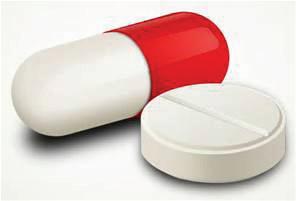
Pills Tablets
Capsules
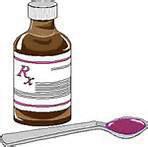
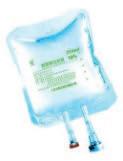


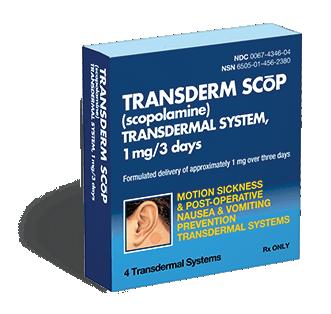


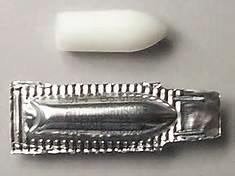
Liquids
Infusion Bags
Add water or soda to the pill bottle (container). Wait until the pills are dissolved and pour the liquid into your disposable absorbent material OR tape the pill bottle shut with the liquid and pills inside.
If the bottle is large enough, add something inedible directly into the bottle. Examples: cat litter, dirt, coffee grounds or cornstarch. If the container has too small an opening, pour the liquid contents directly into your absorbent disposable material.
Vials
Open vials, or draw up solution and pour contents onto an absorbent pad/disposable adult brief. Discard syringes and empty vials in a puncture-resistant container (See page 65).
Patches
Lozenges
Ampules
Put on disposable gloves to prevent you from coming in contact with medicine that is absorbed through the skin. Cut each package open and remove the patch or lozenge. Place patch or lozenges in an empty disposable container, such as a medicine container, Ziploc bag, or disposable bottle. Add water. Close and secure with tape. Dispose of gloves. Wash hands. (This process does not apply to fentanyl patches. Please see the Hospice Care Training section for instructions on how to discard used Fetanyl Patches on page 42)
Put on disposable gloves. Use a washcloth or kitchen towel to hold the ampule. Bend neck of ampule away from your body and break open. Pour contents into absorbent pad/disposable adult brief. Dispose of ampule in a puncture-resistant container such as a coffee can with a lid. Secure with tape. Dispose of gloves. Wash hands.
Suppositories
Open the end of the suppository packaging and place the entire contents in an empty plastic container. Add water, cover container and secure with tape.
For more information on medication disposal and medication disposal options, go to: http://www.dep.state.fl.us/waste/categories/medications/ http://www.dep.state.fl.us/waste/categories/medications/pages/disposal.htm
Safe Disposal of Needles & Syringes (Sharps)
Handle All Sharps Carefully To Prevent Injury
Dispose of needles and syringes (SHARPS) in a puncture-resistant container.
Use an empty household container with these features:
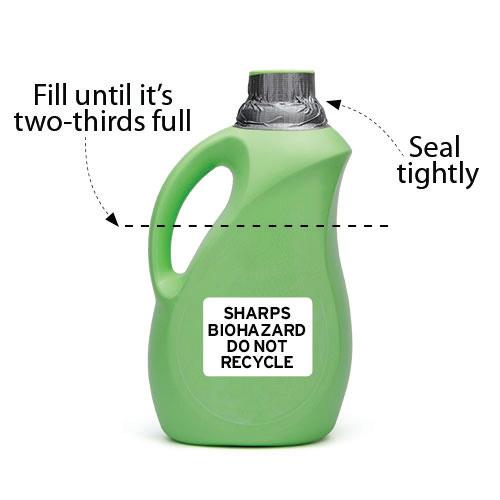
Using a permanent marker write “SHARPS” on the container. When the container is no more than two-thirds full, tape tightly. Dispose of container in regular trash
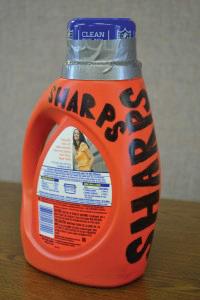
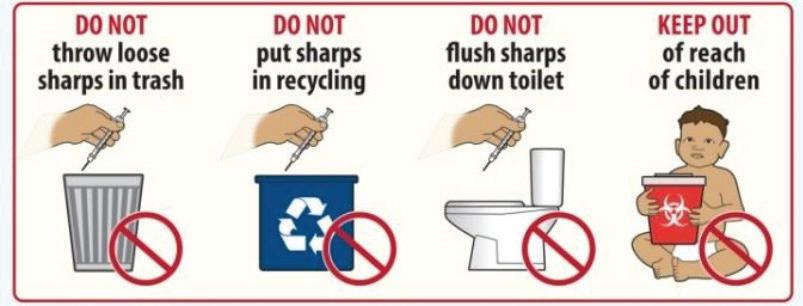
Hospice Care Training: Providing Personal Care & Infection Control
Preventing Infection
Proper Hand Hygiene
Proper hand hygiene is at the top of the list of things you should always do to prevent infection.
• Hand hygiene should be completed:
• Before and after eating, preparing, or serving food.
• Before and after providing personal care .
• After handling soiled/dirty items.
• After sneezing, blowing nose, coughing.
• After going to the bathroom.
• If your skin has blood or body fluids on it (urine, stool, mucous, drainage, pus) it is important to wash the area immediately with soap and water.
• Hand-washing technique:
• Hands should be wet with water and then add soap.
• Lather to provide friction to remove dirt – wash vigorously for at least 20 seconds.
• Rinse thoroughly.
• Dry with a paper towel.
• Turn off water with a second dry paper towel.
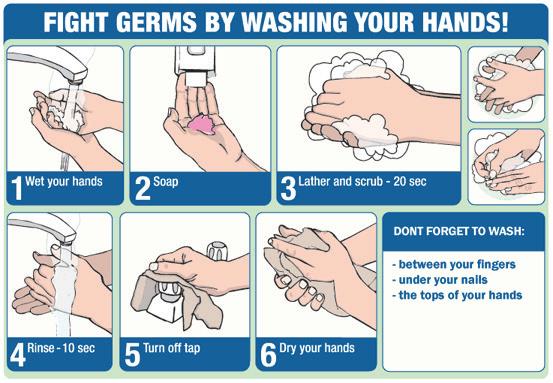
FIGHT GERMS BY WASHING YOUR HANDS!
Alcohol-Based Handrubs
In the event that soap and water are not readily available, you may use an alcohol-based handrub when your hands are not visibly soiled. As soon as you can, perform hand hygiene using soap and water.
Easy as Alcohol-based hand rub
Keep your hands clean! Use an alcohol-based handrub when your hands are not visibly soiled. Wash your hands with soap and water when your hands are visibly soiled.
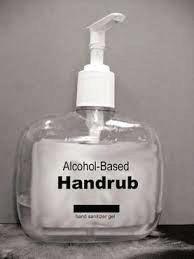
Alcohol-based handrubs provide several advantages over handwashing with soap and water: require less time than handwashing act quickly to kill microorganisms on hands more effective than handwashing with soap and water more accessible than sinks reduce bacterial counts on hands do not promote antimicrobial resistance less irritating to skin than soap and water can even improve condition of skin
How do you use it?
It is as easy as 1, 2, 3... When decontaminating hands with an alcoholbased handrub, use an amount of alcohol-based handrub sufficient to cover all surfaces of hands.
Apply handrub to palm of one hand.
Rub hands together covering all surfaces of hands and fingers.
Rub until handrub is absorbed.
When Infection is Present
• Protect any open wounds or abrasions by covering them to prevent exposure when providing personal care.
• Wear gloves when:
• Providing wound care.
• Coming in contact with blood, body fluids, excretions and secretions.
• If gloves are not available in the home, use anything that would prevent contact with the infected fluid. For example, a plastic bag placed over the hand could be used.
• Wear a plastic gown or apron if directed to do so by your nurse. Plastic gowns or aprons are used to:
• Protect clothing from splashing or contamination with infected blood/body fluids.
• If a plastic apron is not available, the caregiver should tie or pin a plastic bag to the shoulders of his or her clothes to provide coverage while providing care. Cloth aprons may be saturated with body fluids and do not provide adequate protection.
• Wear mask and eye protection if directed to do so by your nurse. Masks and eye protection are used to prevent splashing into the eyes, mouth and nose. These are not usually needed in the home setting.
Mouth Care
Oral hygiene or good mouth care is essential for comfort. Mouth care should be given at least twice a day. Good oral care can help to prevent mouth sores and may improve the person’s appetite.
Skin Care
Skin is the largest organ in the body. It is prone to breaking down at the end of life for many reasons, including immobility, decreased circulation, poor nutrition (lack of appetite) and incontinence (loss of bowel and bladder control).
It is especially important to provide good skin care when a person is confined to bed or has difficulty moving. Watch for any signs of redness or irritation on the skin. Some areas to watch are the back (spine), coccyx (buttocks), heels, and other bony areas.
Things that you can do:
• Keep skin clean (change incontinent pad or brief frequently).
• Wash skin with mild non-soap cleanser.
• Apply unscented moisture lotion.
• Keep bed linens dry and free from wrinkles. Even small wrinkles can be intensely troublesome for someone in bed for long periods of time.
• Change position every two hours.
• Use pillows to support the legs, back and shoulders.
Saying Goodbye: Physical Signs and Symptoms of Approaching Death
Decreased Food and Fluid Intake
Your loved one may want very little or no nourishment, often refusing to eat or drink. Foods previously enjoyed may not taste the same. The person may have difficulty swallowing and experience episodes of choking. This is very natural and normal. As weakness increases, energy decreases and movement decreases. The body’s metabolism slows down and the person requires less nutrition. As the person becomes increasingly weak and drowsy, swallowing and digesting food and fluids often become harder and can place a strain upon the body.
Things You Can Do Now for the Person
Do NOT force food. While giving food is a way of nurturing and showing love, it can be very dangerous to force eating when a person is very weak. Forcing food will not slow down the natural end-of-life process DO:
• Provide foods that your loved one asks for.
• Provide good oral hygiene.
• If the loved one is eating and drinking less, keep his or her mouth moist.
• Moisten the mouth with a damp sponge (special kinds of sponge are available for this pupose). The person may bite on this at first, but keep holding it and, he or she will let go.
• Place ice chips in the mouth.
• Apply lip balm to keep lips moist.
Changes in Sleeping Patterns
The person may begin sleeping more and communicating less. At times it may be hard to wake him or her. The loved one may confuse day with night and awaken just when you are ready to go to sleep. This is a normal part of the dying process. Extreme tiredness makes it hard for a person to sustain a conversation.
Things You Can Do Now for the Person
• Make the most of the time when he or she is awake.
• Sit quietly and just hold the loved one’s hand.
• Try not to awaken a person who is sleeping or unable to respond.
• Speak normally, even if the person doesn’t seem to respond.
• Assume the loved one can hear you.
The sense of hearing is usually the last sense that remains.
Changes in Bladder and Bowel Functioning
Your loved one may lose control of his/her bladder and/or bowel. Loss of bowel and bladder control is the direct result of muscle weakness. As general weakness increases, the muscles that control these functions also relax, which may result in incontinence.
In addition you may observe the person’s urine color is darker and urination quantity and frequency are less. As fluid intake decreases, the urine becomes more concentrated (darker) and amounts are smaller.
Loss of bowel and bladder control can be extremely distressing for both you and your loved one. Talk to your hospice team or call Trustbridge about any fears or concerns that you have.
Things You Can Do Now for the Person
• Help make him or her comfortable and maintain privacy and dignity by:
• Use of protective covering for the bed (incontinent pads).
• Use of adult incontinent diapers.
• Practicing good hygiene – use disposable gloves when providing incontinent care.
• If your loved one has been dry for a long period of time (hours) and shows signs of new or increased agitation or pain, Contact Trustbridge.
Changes in Body Temperature
• Your loved one may go back and forth between being hot and sweaty to being cool and dry. This intermittent change in temperature is the result of changes in the body chemistry that affect the brain’s thermostat. This is normal at end of life and does not usually signal an infection.
• Your loved one may also develop coolness in the hands and arms and/or coolness in the legs and feet. At the same time the lower part of the body may become darker and look blotchy or mottled. The brain is shutting down circulation to the hands and feet in order to direct blood to the vital organs.
Things You Can Do Now for the Person
Try the following to make the person comfortable if he/she is hot:
• Check to see if the person has a fever. Ask Trustbridge whether giving acetaminophen (Tylenol) would be appropriate to lower the temperature. If your loved one is unable to swallow, the medication may be given as a rectal suppository.
• Keep the room cool. Consider using a fan. Cover the loved one lightly with a sheet rather than a blanket. If the person is in a hospital bed, drape the sheet over the side rails rather than placing it directly on your loved one.
Try the following to make the loved one comfortable if he or she is cold:
• Keep the person warm with a blanket.
• Do NOT use an electric blanket or a heating pad.
Restlessness, Agitation, or Confusion
Shortly before death some people become restless, agitated and confused. You may observe your loved one repeating tasks or movements such as “picking” at sheets or tossing and turning in bed. Agitation may be severe, causing the person to sit up or try to get out of bed. This is known as terminal restlessness and it often occurs within the last few days of life. It affects nearly half of all people who are dying. If you ask your loved one what is the matter, he or she will probably not be able to tell you or whatever is said will have no real meaning. This can be very difficult for you, so it is important for you to remember that this is a result of the disease and what is happening in the person’s body.
Things You Can Do Now for the Person
• Keep the room well-lit during the day.
• Place a clock close by so the loved one can see the time.
• Minimize noise levels in the room.
• Speak calmly and softly.
• Explain all actions before they are done.
• Promote relaxation and sleep.
• Give medications as ordered by the physician.
• Share your feelings with your Trustbridge team. We are here to listen. We know that it can be devastating for you to experience the confusion of someone who has been vital and in control. You may also wish to share your feelings with someone else that you are comfortable with.
Dream-Like Experiences
Seeing people who have already died or “visiting” an especially beloved place are often shared by dying people. Some statements may seem bizarre or out of character. This is a part of preparing to make a transition from this life. Many believe that those who have already died, but who were meaningful and loved in the patient’s life, may appear to make the journey less frightening.
Things You Can Do Now for the Person
• Take comfort in the fact that this is a natural and positive process and occurs to put the patient at ease with what is happening.
• Do not be afraid.
• Listen and believe your loved one when the person tells you what he or she has seen. You may not be able to see these “guides,” but that does not make them less real to your loved one.
Congestion and Changes in Breathing (Terminal Secretions)
As the last hours of life approach you may hear rattling or gurgling breathing sounds. Sometimes these sounds are quite loud. This happens because saliva (normal fluids) “pool” in the back of the throat and upper airways. Your loved one has become weaker and it has become increasingly difficult for him/her to fully clear these normal secretions.
Keep in mind that these noises may be far more disturbing or frightening to you than they are to your loved one. You may also observe changes in the breathing pattern. Sometimes the patient breathes rapidly alternating with periods of no breathing (called apnea). This pattern is called Cheyne-Stokes breathing. The stimulus to breathe is not caused by lack of oxygen in our bodies, but by the build-up of carbon dioxide. The brain of a terminally ill person is much less sensitive to this build-up. You may notice a period of apnea while the carbon dioxide accumulates to the level needed to trigger a breath. Your loved one may take several rapid, shallow breaths, which allow the body to “blow off” the carbon dioxide. There may then be another period of apnea. This pattern occurs while the patient is asleep but not while awake.
Remember:
• This is a natural breathing pattern for a dying person and generally does not cause discomfort.
• Administering oxygen does not alter the breathing pattern.
Things You Can Do Now for the Person
• Elevate the head of the bed and gently turn your loved one’s head to the side. Gravity will work to drain secretions.
• Wipe the mouth with a soft, moist cloth. (Suctioning would irritate the oral tissues and cause increased secretions.)
• Keep the room cool.
• Circulate air so it blows on the face.
• Talk to the hospice nurse about medication to reduce the amount of secretions.
Saying Goodbye
It is not unusual for people at the end of life to hold on, even though they are suffering. This is especially true for those who have been authority figures or whose family is in conflict. In order to let go, your loved one needs to know that those he or she is leaving behind are going to be able to flourish on their own.
You can:
• Stay focused on giving one of the greatest gifts possible to your loved one – the security of knowing that you will be all right and that your loved one has your permission and encouragement to let go.
• Say goodbye, knowing that the patient, and you, may both need to hear this.
• Don’t be afraid to cry. Tears are a natural part of the experience; they express your love. Don’t try to hide them.
• Acknowledge that your loved one’s absence will create a void in your life, but that you recognize the person’s need to move on. You might say something like, “I will miss you, but I will be ok. It’s time for you to let go.”
• Be aware that making your loved one feel guilty about leaving you can cause great distress, as can trying to keep the person from moving on in order to meet your needs.
What Happens When Death Occurs
We hope that your Trustbridge team, along with the information conveyed in this booklet, help to make the experience of your loved one’s death less frightening and anxiety-producing for you. We encourage you to reach out to us whenever needed. Our goal is to support you throughout the journey.
We can’t tell you when the moment of death will occur. People can hover between life and death for hours and often days, and it is easy to miss the final moment. It has been speculated that individuals who are very private, or who are afraid of causing their loved ones undue anguish, may choose to die when there is no one else in the room. Others are thought to wait for a particular person to arrive to say goodbye or a particular date that has meaning to the family to pass.
The most important thing to focus on is creating a peaceful, soothing atmosphere for the person you love and to say all the things that you want the loved one to know. (whether or not the person is able to respond.)
When death occurs it happens very quickly. Even if you have never been present at a death, most people will recognize that it is taking place.
Sometimes the person will give several outward pants as the heart and lungs stop. Others may give a long exhale followed quite a few seconds later by another intake of breath. This may be repeated several times before breathing stops entirely. Other indicators are very clear:
• There will not be a pulse (heartbeat).
• There will not be any breathing.
• There won’t be a response to voice or touch.
• The person’s eyes may be open.
• The skin tone may take on a pale or waxy look.
• The facial expression may change or loosen.


What To Do When Death Occurs
Have a plan before the death occurs.
• Choose a funeral home well in advance and provide the name to either the hospice nurse, social worker or chaplain. This will make things much easier for you when the time comes. If possible, also consider making the arrangements in advance. It is better to make choices at a less stressful time than at the last minute.
• Make a list of people and their phone numbers for notification.
• Consider writing the obituary (if you wish to have one published).
• Locate all important papers (insurance, investment, etc.).
At the time of death Trustbridge is here to assist you. Call Trustbridge at 1.888.441.4040 (Do NOT call 911 or the police)
Trustbridge will:
• Notify the physician.
• The funeral home will send the death certificate to the physician for signature.
• Contact the funeral home for you. The funeral home will arrive in a relatively short time.
• Normally the funeral home will come as soon as possible to transport your loved one.
• Provide needed support.
• Many people want the support of their own spiritual advisor or the hospice spiritual counselor/ chaplain. We are here to support you in any way possible. Let us know if you would like the hospice chaplain’s support.
• Arrange to have equipment picked up.
• Most people are anxious to have the hospital bed and other equipment removed as soon as possible. Our medical equipment company will be in contact with you to facilitate removal.
• Remind you to destroy medications appropriately (see medication disposal information in this book).
Care of Your Loved One
It is not necessary to do anything special with your loved one’s body. However, it is advisable to lower the head and foot of the bed to a flat position.
If you wish to provide personal care you may. Some people wish to wash and dress the person in clean garments before the funeral home comes. If that is your wish, let Trustbridge know.
Our care and support don't end here. We are here to guide you through your grief journey.
The death of a loved one can be one of the most difficult experiences any of us will face. It is our hope that throughout the end-of-life transition, you and your loved one felt supported and cared for. It has been a privilege and honor to be part of your loved one’s life as well as yours, and we wish to assist you in any way possible as you begin a new journey: one of healing and renewed vitality. It will take time, and we are available, willing, and prepared to support you, step by step, through your personal process of grief. As the focus of our journey with you shifts to your care, please know that we hold this trust with the same sense of privilege as we held the trust between your loved one and us.
Although each person’s grief reaction is a unique and personal experience, many often find a commonality in the complexity of grief. Grief reactions can affect people emotionally, physically and spiritually. Experiencing grief is a normal and natural reaction to the loss of a loved one, and it can be overwhelming. If you feel like you need additional support in your grief, Trustbridge Bereavement Centers are here for you. Please call us and we will assist you in finding the grief support that best meets your needs. You do not have to walk this path alone. We are here for you.
We know that a self-guided journey of contemplative reading and videos can be helpful at any point during your grief journey. We invite you to explore the resources on our website and know that we are here for you if you would like additional support.
If we can help you, please call our Trustbridge Bereavement Centers toll-free at 1.888.499.8393 or scan the code to learn more.


Trustbridge Hospice Foundation
The Trustbridge Hospice Foundation is committed to providing extraordinary care for patients in need, including those without insurance coverage or the ability to pay. Thanks to the generosity of our community, we are able to go above and beyond what is covered by Medicare, Medicaid and private insurance to offer specialized services and exceptional care to every family who needs it.
Each year, Trustbridge Hospice Foundation provides an average of $5 million to ensure that over 12,000 patients and families in Palm Beach and Broward Counties are able to receive the end of life care they deserve, including:
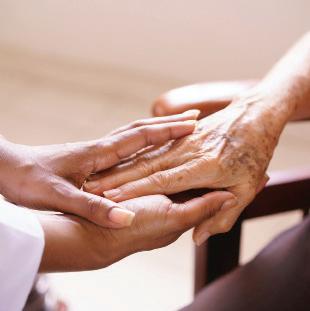
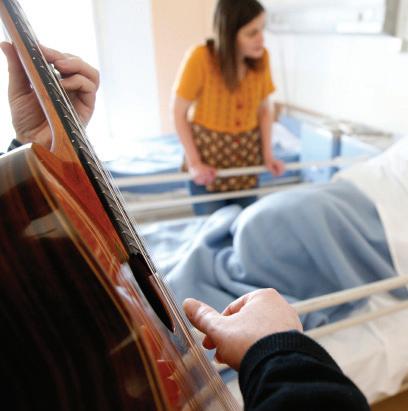


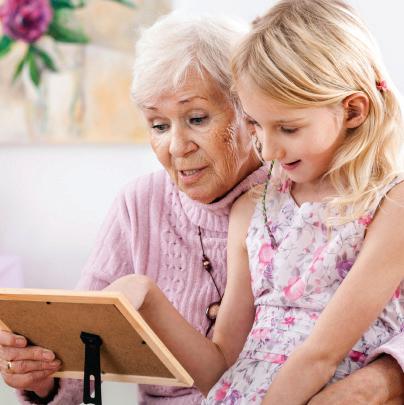


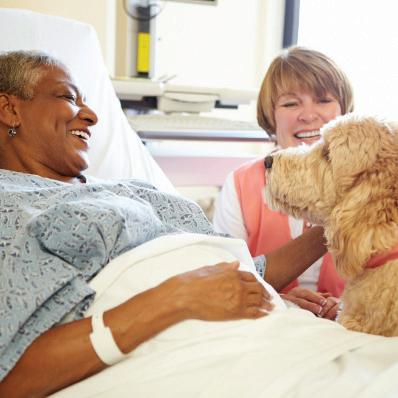
Grateful Families Make a Difference
Having a loved one on hospice touches the lives of many: parents, siblings, grandparents, extended family, friends, and the community. Trustbridge strives to bring compassionate and loving care not only to the patient but also to that extended network of family and friends.
Many of the families that we serve ask how they can recognize their Trustbridge caregivers whose kindness and compassion was especially meaningful to them.
Our @Heart Grateful Giving program provides an opportunity to say “thank you” and recognize the care that you and your loved ones may have received.
For more information, please visit trustbridge.com/foundation or call 561.494.6888.
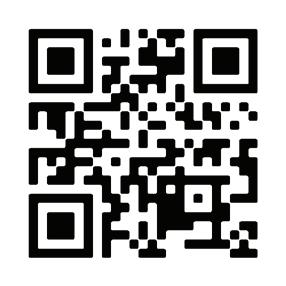

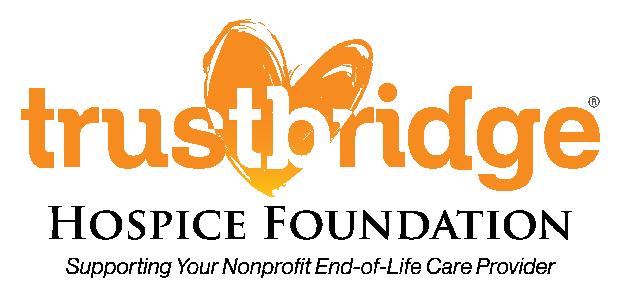
Charity Care Music Therapy Veterans Programs Physician Fellowship
Bereavement Programs
Grief Camps for Children
Nursing Internships Pet Peace of Mind
Vision
To provide an unmatched healthcare experience for families in their time of need.
Mission
To provide families with access to compassionate, expert and professional healthcare services in their time of need, throughout their lifespan.
Values
• Excellence
• Integrity
• Teamwork
• Compassion
• Accountability
• Pride




